The Paris Review's Blog, page 90
February 17, 2022
The Review‘s Review: Ye’s Two Words
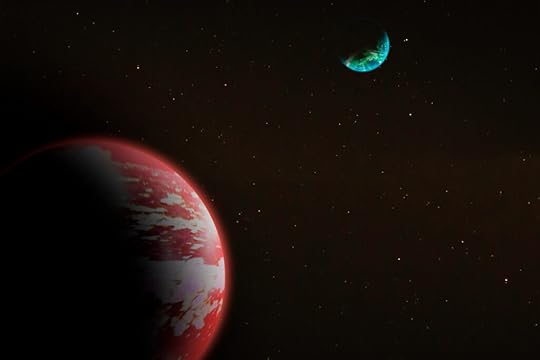
A red planet in the foreground with a green planet in the distance, set in a starfield. Image courtesy of Adobe Stock.
In the wee hours of this morning, Ye shared a flurry of Instagram posts. There were videos advertising his proprietary Stem Player, which he claims will be the only place fans can listen to DONDA 2, the album he plans to release next week. “Go to stemplayer.com to be a part of the revolution,” he wrote. The Stem Player, which allows users to remix music by manipulating stems, or the individual, elemental parts of a song, is a disc covered with what looks like semitranslucent tan silicone, featuring blinking multicolored lights that correspond to the tempo and other aspects of a currently playing track. Its design is of a piece with Ye’s Yeezy aesthetic: earth tones complemented by bright hues, like a Star Wars scene set in Tatooine. His posts recall George Lucas’s series in their narrative messaging as well: Ye highlights the battle between an evil empire—in this case, the music and tech industries—and an intrepid revolutionary, himself. “After 10 albums after being under 10 contracts,” Ye explains, he is ready to control the means of distribution. “I turned down a hundred million dollar Apple deal. No one can pay me to be disrespected. We set our own price for our art. Tech companies made music practically free so if you don’t do merch sneakers and tours you don’t eat … I run this company 100% I don’t have to ask for permission … I feel like how I felt in the first episode of the documentary.”
“The documentary” is jeen-yuhs: a Kanye Trilogy, a nearly five-hour bildungsroman that premiered at Sundance in January and is distributed by Netflix. Directed by the filmmakers Coodie Simmons and Chike Ozah, who made Ye’s first music videos, jeen-yuhs is shot in what appears to be vibrantly colored 8 mm—something of Coodie & Chike’s trademark—and is narrated by Simmons, who quit his job as a comedian and public-access host in Chicago to follow his friend’s journey. It’s a culmination of over twenty years of documentation and hundreds of hours of footage. Consequently, the film plays like a very long, intimate home video.
In the trilogy’s first part, which premiered on February 16, it’s the early aughts: Ye is hustling in New York City and working on what will become his 2004 album, The College Dropout. This is the portrait of an artist as a twentysomething young producer, a successful beat maker struggling to be taken seriously as a rapper. He goes into Roc-A-Fella’s offices and plays his music for busy A&R and marketing professionals, who half listen in between phone calls. We see him playing his instrumentals for other rappers, driving around New York delivering tracks, taxiing through the city with CDs of beats, waiting for his career to take off. We see him waiting in the wings of another rapper’s concert anticipating his chance to get on the mic, and then buying a porn mag from a newsstand. We see the empty refrigerator in his Newark bachelor pad. We see him spending time with his mother, the late Dr. Donda West, in her Chicago apartment. Dr. West’s confidence in her son’s abilities is touching; while watching Ye and his mom rapping one of his early songs in her kitchen one late night, I had to wipe my eyes. In this film, we see Ye built bit by bit; we see his stems.
One of today’s predawn posts was an excerpt of a track called “Fuck Flowers”: a video of the Stem Player playing the song in the dark, its blinking nodes like a pulsing beacon cast from a lighthouse, beckoning insomniacs, those in other time zones, and workaholics to come and listen. The device’s undulating light show matches the rhythm of Ye’s recent Instagram activity, which has functioned as a rapidly changing post-and-delete diary of his thoughts. For the past few weeks, he’s been sharing dozens of posts, which vacillate between harassing his estranged wife, Kim Kardashian, and her boyfriend, Pete Davidson; promoting his new album; and expressing a desire to restore his marriage. Beginning with 2016’s The Life of Pablo, an album notorious for its ever-evolving tracklist and sequencing, Ye has been editing his art to fit his moods. At the same time as he started live-editing his art, he began live-tweeting his thoughts. In 2018, for example, he ecstatically expressed his ideas about Donald Trump’s “dragon energy,” and his emoji skin-color preferences. Ye’s impulse to share has only intensified. On Sunday, he wrote, and subsequently deleted,
HERE’S SOMETHING I HAVE TO DISPEL MEANING REMOVE THE SPELL THAT PEOPLE ARE UNDER WHY DOES A MEDIA OUTLET GET TO POST 20 TIMES A DAY BUT IF I POST THAT AMOUNT THERE’S SOMETHING WRONG ISN’T INSTAGRAM OUR OWN PERSONAL MEDIA PLATFORM? … I LOVE BEING IN CONTROL OF MY OWN NARRATIVE “I FEEL KIND OF FREEEEEE”
The contrast between Ye’s impetuous Instagram dispatches and the thoughtfully arranged, two-decades-in-the-making jeen-yuhs is a fruitful artistic juxtaposition: between a hastily assembled chronicle and a more reflective composition. We can see two chronologies in motion, two contradictory but complementary records in play, suggesting distinct, but overlapping destinies—hinting, like Tatooine’s binary sunset, at elliptical experiential timelines. Holding the two together means witnessing a pleasant anachronism, as sweet as Ye’s old sped-up soul samples. “We get a good juxtaposition now in this film between the two lenses,” says Chike Ozah, referring to balancing the media’s critical view of Ye with a more empathetic one, in an interview with Netflix. On the College Dropout classic “Two Words,” Ye plays with the power of contrasting pairs: it features Freeway, who was then a hard-core street rapper, and Mos Def (now known as Yasiin Bey), the Toni Morrison–quoting indie-rap darling. Throughout the song, the featured artists use the refrain “two words” before juxtaposing sets of images. Ye begins his verse by establishing the scope of his playground—“Southside, worldwide”—which is both local and cosmopolitan. In light of the duality offered by his social-media narrative and the documentary—a long view alongside a short one—I wonder what words he’d use to describe himself now. For me, two words come to mind: recording artist.
In one jeen-yuhs scene, filmed with Ye and Dr. West at his childhood home, the musician says, pointing at the space where a full-length mirror used to be, “I used to just practice in front of it.” It’s not hard to imagine; in several scenes, Ye flexes for the camera, posing and preening. Oh, how things have changed. For Ye, these days, mugging in front of the camera is like mugging in front of a mirror. At the beginning of the film, a Roc-A-Fella A&R rep asks him, “You still doing your documentary? I thought it’d be finished.” Ye replies, “It’ll never be finished.” —Niela Orr
I knew that Joachim Trier counted Arnaud Desplechin’s 1996 film My Sex Life … or How I Got into an Argument as an influence—he said as much at a recent talk at Lincoln Center—but was delighted by just how deeply Trier’s new movie, The Worst Person in the World, reminded me of the former when I finally saw it last week. The Worst Person in the World, like My Sex Life, is a freewheeling exploration of one’s early thirties—that delicate age at which actions do indeed begin to have consequences but it’s still fun to occasionally blow up one’s life in a moment of boredom. From the voiceover to the adultery plot points to the menstrual-blood shower scene, Trier borrows freely from Desplechin, though he swaps the gender of his main character, Julie. The result is a witty, realistic look at the highs and lows of finally growing up, and might include the best sex scene I’ve ever seen—it’s certainly the best sex scene in which the characters don’t even touch each other. —Rhian Sasseen
I first encountered the work of Oscar yi Hou—now an upcoming solo exhibitionist at the Brooklyn Museum after winning their third annual UOVO Prize—when I saw his A sky-licker relation at James Fuentes Gallery late last summer. The exhibition is a series of portraits, mainly of young Asian people. The subjects, through their various positions of vulnerability, stoicism, solitary ponderance, and mutual affection, stare directly out of intricate, kaleidoscopic frames to meet the eyes of their audience, positioning the viewer such that they take up the gaze that was once held and reciprocated by the artist. This dynamic between creation, creator, and beholder is simultaneously mediated and immediate, spontaneous and reenacted—an experience that is communal but also intensely concerned with the individuality of personhood. Seeing yi Hou’s work amidst a crowd of other twentysomethings fresh into the gallery from a day that had been hot and damp, hopelessly sweating through an outfit I had probably chosen with great effort for the occasion, I was faced with exactly that: the discomfort, the relief, the multiplicity and solitude of the person.
With me at the exhibition were several people who had modeled for the paintings. I saw them as they existed both in the real world and within the complex iconography in which the artist had immersed them: the dragon, horse, and ox of the lunar calendar; ornate lettering reminiscent at once of ancient calligraphic practices and contemporary American street graffiti; golden stars denoting the Chinese flag as much as the classic westerns of old Hollywood. Graceful and precise, these aesthetic references index their subjects as global intersections of past and present, living fulcrums upon which a multitude of dreams and inheritances—fame, beauty, nationhood, belonging—have come through time to balance. Standing before their portraits, sharing with them my reality and the collisions of perspective inherent to it, I felt that transhistorical identity reflected within myself. —Owen Park
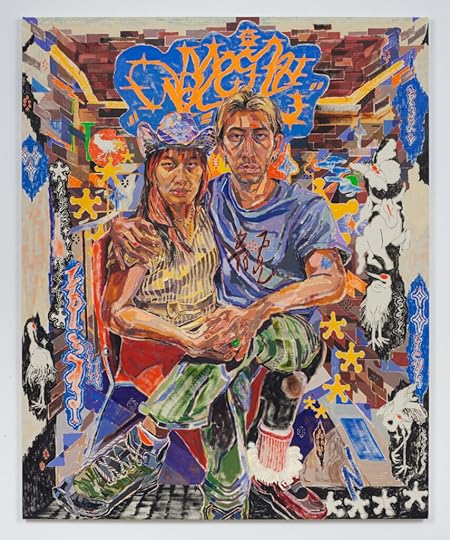
Far Eastsiders, aka: Cowgirl Mama A.B & Son Wukong, 2021, signed and dated verso, oils on canvas, 61 x 49 3/8″. Photo by Jason Mandella, courtesy of Oscar yi Hou and James Fuentes.
Don’t Delete: A Visit with Billy Sullivan
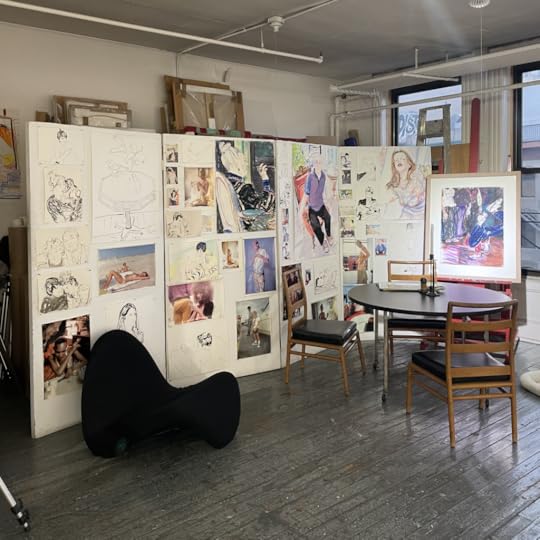
Billy Sullivan’s studio. Photograph by Lauren Kane.
Billy Sullivan’s studio, a fifth-floor walk-up on the Bowery, has a comfortable, elegant dishevelment. Hanging all around the space are some of the brightly colored figurative paintings he has been making since the seventies: portraits of his friends, lovers, and other long-term muses, rendered in loose, dynamic brushstrokes and from close, pointedly subjective angles. A still life of a bouquet and two coffee cups is an outlier among the faces. Near a work in progress on the wall is a table with a color-coded array of pastels, each wrapped in its paper label (mostly the artisan Diane Townsend, with a few older sticks from the French brand Sennelier); a metal cart bears tubes of oil paint, and reels of film negatives are tucked away on low shelves. Tacked up on a set of folding screens is a display of Sullivan’s photographs and sketches, and next to that is a burgundy chaise longue adorned with a faux animal pelt. When I visited on an overcast afternoon in December, Sullivan had set out a bowl with grapes and a fig on the kitchen island, where he pulled an espresso for himself and poured a glass of water for me.
I had brought along a copy of Gary Indiana’s 2003 novel Do Everything in the Dark, a contemporary answer to George Eliot’s Middlemarch, which follows a tight-knit group of artistic New Yorkers who, over the years, have either realized or surrendered their potential for happiness. As Indiana explains in an Art of Fiction interview in the Winter 2021 issue of the Review, the novel began as a series of vignettes intended to accompany Sullivan’s paintings of people they both knew in the “downtown” scene. We looked through images together, and Sullivan told me some of the stories behind them. That milieu—Cookie Mueller was a part of it, as were Andy Warhol, Jackie Curtis, and the FUN Gallery founder Patti Astor—flourished for only a few years, from the late seventies through the tragic onset of the AIDS epidemic, and is often fetishized, much to Indiana’s irritation. The very word downtown carries a whiff of romance, especially when spoken by those too young to have known an era when you could live in Lower Manhattan on next to nothing. “There was a lot more free time,” as Sullivan puts it, and to be an artist essentially meant that “you got respect from your peers and you hung out with people you really liked.”
Sullivan is mild-mannered and considers himself a wallflower, an observer. While we sat and talked, he kept lifting his phone to take quick images of me as I fidgeted, recrossing my legs or tying up my hair. His photographs—he calls them his sketchbooks—have a loose, spontaneous quality, conveying an intimacy that invites the viewer in. The second time I referred to them as “candid,” he corrected me. For Sullivan, there is no distinction to be made between a candid photograph and any other kind.

Gary, 1997, pastel on paper, 42 x 30″. All images copyright Billy Sullivan. Courtesy of the artist and Kaufmann Repetto, New York and Milan.
Gary was always around at night. I was interested in the way he wrote—dynamite art criticism. His writing was sort of like poetry. We ran pretty much in the same places at the same time. I’d see him when I went to the barber, and we’d go to the same restaurants, too, like Mickey Ruskin’s at One U. Places where you could go and get food and it didn’t cost anything. One U took the place of the back of Max’s Kansas City, where it first started for me. You would go to One U at around ten o’clock. Everyone would show up there, and you would play around. And then there was the Mudd Club. Gary would go. It was what you did at night. And it would be whoever was interesting. We never thought of it as the underground. It was just the world, and everyone was hanging out. You wouldn’t call somebody and say, “Are you going?” You would just show up.
You didn’t want to use the phone. There was all this paranoia because we were anti-war, we were anti all these things. And the older people, like Brice Marden and those guys, they would be really frightened of the FBI.
Gary became a muse for a while. We became friends over a long period of time, and it was always interesting—something was always going crazy in his life, and you got to hear that. We would have these long telephone conversations, kind of piecing together what happened the night before. In the morning you would check in and see when you left somewhere and what you did. It used to be a whole part of my life was, the next day, trying to figure out what exactly happened.

Cookie’s Secret #1, 1983, pastel on paper, 62.5 x 42″.
Cookie Mueller had a place on Bleecker Street between Sixth and Seventh Avenues. And you’d go there, like before you’d go out at night, and get whatever you needed. Lots of times you went to Cookie’s to get drugs and get ready to go out. She’d be putting on her clothes.
Cookie called me a diarist. She used to work for some place called Details, and she wrote that in a review in there. And I liked it. It sounded like what it is. This is my diary.
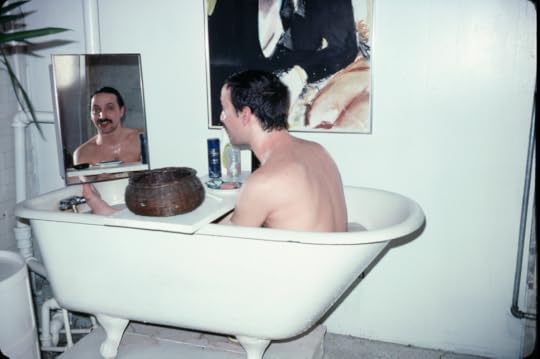
Frank, April 1977, 1977 (printed 2017), digital c-print, 16 x 24″.
I get to go to lots of people’s bathrooms. That’s just, I’m friendly.

Anne, March 1985.
This is Anne, my husband Klaus Kertess’s best friend. She was a beard when we would travel sometimes. They were opening the Morgan Hotel, and she was doing a big party. And that’s the first bathroom at the Morgan. That’s her drinking her wine, talking on the phone, her favorite thing. Now she just texts.
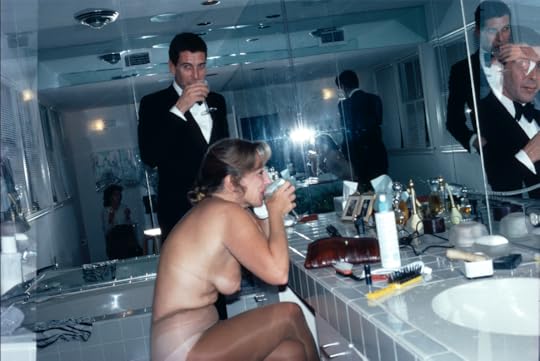
Anne and Klaus, 1981 (printed 2002), digital c-print, 13.5 x 20.25″.
That’s Anne in the bathroom in Fort Worth. They were getting ready to go to a big party at the Bass Hall, and Klaus was doing an art show then, for Laura Carpenter. They’re having margaritas before we went out. When we got to parties in Fort Worth, Anne would give everybody an individual vial of cocaine so that we wouldn’t go into the bathrooms together, because she’d get in trouble.

Michael and Naomi, 1971, 1971 (printed 2011), digital c-print, 30 x 20″.
Naomi Sims was the first really big Black Halston model. She was married to Michael Findlay, who is an art dealer. And she came to my house on Eighty-Seventh Street, all decked out in the Halston, just to have dinner, and to drink and have a good time. She was the most elegant woman ever.

Eileen, 1998, oil on linen, 30 x 20″.
I’m good at red. I got interested in them because they hung out with Jimmy Schuyler, and I always thought he was the most brilliant poet. I’d see him at Fairfield Porter’s house in Southampton, and he must have been on Thorazine or something. He’d just be sitting there like that, but still brilliant.

Patti Astor, 1979, pastel on paper, 42 x 46″.
Patti Astor had a place in the East Village. One day we went over there, and you had to bring her a bottle of vodka. She had great makeup. She was something else. She was one of the beginnings of the East Village—she pulled all that together. This is in her home at like one o’clock in the afternoon. You know, the mattress on the floor with some pillows and Marlboros and ashtrays …
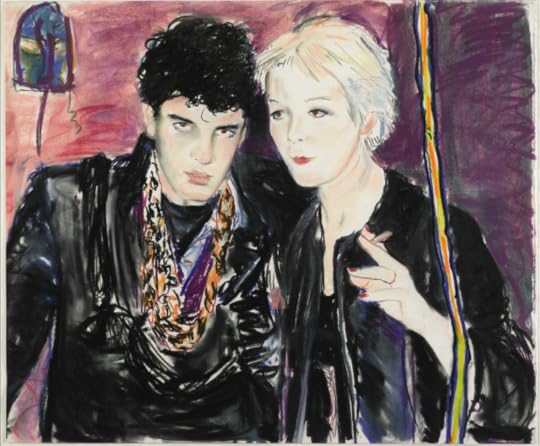
Louie and Patti, 1979, pastel on paper, 30.25 x 39″.
And that’s Louie Chaban. He was going out with Rene Ricard, then, that’s how I met him. Louie was once the doorman at the Mudd Club, and then when Soho started having fashion as well as art stores, he worked for Anna Sui. I’d go visit him when I was looking at art there, and we would take pictures, and we’d go out at night. I can be fascinated by somebody, totally involved in that person, and I can spend years doing it. Louie is somebody who I’ve done from when he had a twenty-six-inch waist until … He’s this big, huge, grumpy man now.
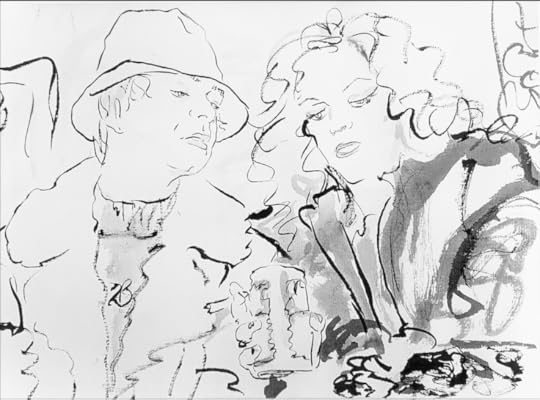
Gary and Cookie, 1981, ink on paper.
Gary and Cookie again. They were perfect together at night. They just had this whole conversation going. She seemed like she was always kind of whispering in someone’s ear. I’ve never seen Gary be really loud, and I don’t think Cookie had to be loud. She could get anything she wanted just being Cookie.
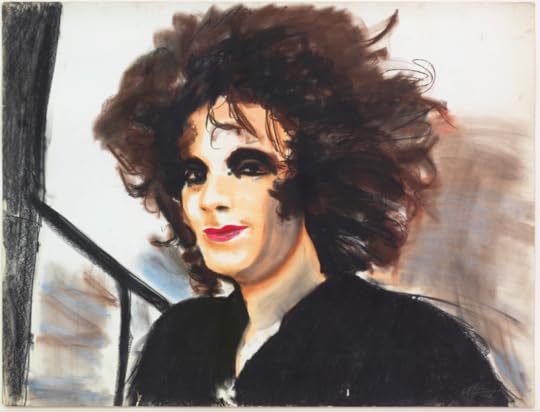
Jackie Curtis, 1971, pastel and watercolor on paper, 35 x 46″.
Jackie Curtis and I were in high school together. I didn’t know that until she told me later. My studio was on Eighty-Seventh Street, I had a spiral staircase. She came over and we started playing around. She was trying to get some money to make a movie. I worked on plays that she was in, too—I did sets for Andy Warhol. This is from around the same time as that great portrait by Alice Neel of her and Ritta Redd. Ritta Redd was there the same night, and Andrea Whips and Warhol were with us. It was a total Factory thing.

Stephen Hall #1, 1972, pastel on paper, 35 x 26″.
He was a boyfriend of Rene Ricard’s. He got undressed that day. It was really nice.
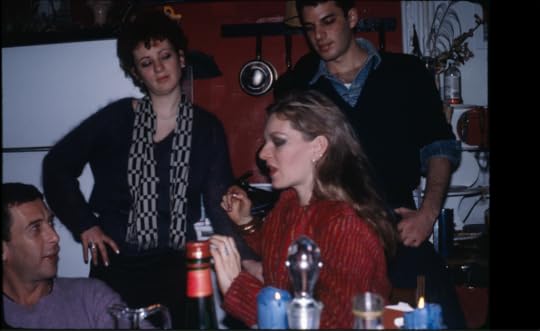
Klaus, Nan, Cookie, and Louie, March 1980.
I never really paid attention to my photographs, because I just used them for reference. Some of them have become drawings and paintings. I could take a picture in 1979 or 1980, and I could make a painting in 2004 of that image—I can go right back and be there.
I never knew they were sketchbooks until somebody was doing a book about me. What they wanted were my photographs. And then I started noticing that they’re relevant, that they really mean something. They lock a time and a place, and puts me somewhere. They block time, so I don’t have to think about time. All I have to do is remember to organize my images. I tell kids now, “Don’t delete your images, because images that you delete today, one day will really look good.” Sometimes you can’t see what things look like until time passes. It’s like if you write for a living. You’ll write something one day. The next day, you’ll look at it. You don’t think it’s any good. And then a week later, it really makes sense, what you wrote. And that’s the same thing with images.
I used to love it when it was film in cameras, because you didn’t see anything. The film had to go away, and then it had to come back, and then you’d look at it. This time period that it took, it was kind of like sobering up—“Oh, this is what it was.”
Lauren Kane is an editor at The Paris Review.
Hunger Moon
In her monthly column, The Moon in Full , Nina MacLaughlin illuminates humanity’s long-standing lunar fascination. Each installment is published in advance of the full moon.
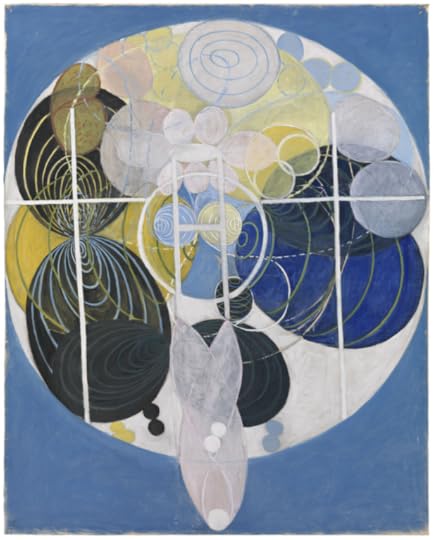
The Large Figure Paintings, No. 5, Group 3, Hilma af Klint, 1907. Image courtesy of Wikimedia Commons.
I
In a driveway in San Jose, California, faded winter sun shone off the waxy tongues of the biggest jade plant I’d ever seen. The person I was with, whose mother’s heart had stopped four days before, unloaded things from a rental car. His stepfather, who I’d been warned was “a strange man,” pulled in behind us, back from collecting his wife’s ashes. He walked over with a cardboard box, anonymous and regular as any box you’d see on a doorstep, and stood by his stepson, holding this box. The man hefted the box in his hands and said, in a tone I cannot describe as anything other than merry, “You wouldn’t believe how much your mom weighs stripped of water and bodily liquid.” Something exited the person I was with, as though his bones had changed density, and he leaned back into the trunk of the car. The stepfather started to speak again—“Or fluid is the word, isn’t it, bodily fluid, blood and …”—and I moved toward him, opened the door to the kitchen, and held it for him. “Here,” I said, and he walked through it and the door swung closed and through the plexiglass I watched him place the box on the kitchen table, next to a bowl of persimmons and a bouquet of white carnations neighbors had sent in sympathy.
The next day, a boat took us out to sea from the San Francisco Bay. The captain cut the engine, the boat rocked in the waves, and the stepfather dropped the ashes, held in a dissolvable vessel designed for such ceremonies, into the Pacific Ocean. Shaped like a small flying saucer, with a sunset scene painted on top, the vessel bobbed. The woman’s grandchildren threw clippings from her beautifully tended garden. Sprigs of sage, roses, and six lemons from her lemon tree. “It’s sinking,” someone said of the vessel. “It’s designed to,” said someone else. Soon it was swallowed, absorbed into the deepest deep. And sooner than anyone expected, the motor churned, the boat lurched back into motion. Our small group stood at the bow and watched the garden matter recede, tumbling in the wake. The lemons, buoyant, bobbed and dipped on the dark surface of the sea.
II
The root of a tooth cracked and had to be extracted. On a sunny midwinter morning, a strong doctor used her strength to remove the tooth farthest back in my lower left jaw. It was unpleasant. Injected and well numbed, the left half of my face was a cementy nonpart of me. I couldn’t feel it but I knew it was there. The doctor put a piece of rubber between my teeth, the texture of a hockey puck, and began to do her work. Her assistant stood behind the chair, held my forehead, and offered encouragement. “Keep breathing.” “You’re doing great.” I could feel the flex of the doctor’s flank against my shoulder. Before closing my eyes, I watched a vein swell at her temple. Nothing hurt, but I did not like the sounds, nor the visible strain required of the doctor. At some point, my mind told me: Your jaw is going to break. “You’re almost there,” said the lady behind me with her palm on my forehead. “Okay, slow your breath.” My jaw is going to break. “Deep breaths now.” My mouth was full of fingers and wrenches and post-hole diggers and crowbars. Naturally, I could not speak my concern out loud. “You need to breathe slower.” My jaw. “Okay now, easy, easy, we’re almost there.” “It doesn’t want to come,” the doctor said, quietly, sounding baffled and vexed. The lady put her other hand on my shoulder. Shallow, frantic breaths. “Deep, slow breaths now, you’ve got to slow your breaths.” And then I heard myself cry out, a high-pitched yelp, involuntary. And in that moment, the doctor said, “It’s out, it’s out, we got it, it’s out.” I dissolved into the chair. The room spun. “Do you want to see?” she asked. Dizzy, sweating, high off the chemicals my body had delivered to my bloodstream, I nodded, and she held out a wad of gauze on her open palm, my tooth as big as an acorn, long tendrils of bloody root. I might’ve been hallucinating.
Ten days later I returned, with more of my wits about me, to have the healing process assessed. “You mentioned bone matter,” I said. A piece of bone matter had been crammed into the socket where my tooth had been, into which a small titanium rod would be inserted, onto which a new fake tooth would be attached. “Bone matter?” I said. “Yes,” the doctor said. “Cadaver bone,” she said. Ghost bone in my face. “In time,” she explained, “your own bone will absorb the cadaver bone, and in time, it will become entirely your bone.” I expressed my amazement. “The body is in a constant state of destruction and creation,” the doctor said. “The body will always try to move toward equilibrium.” Ghost bone in my skull becomes my own bone. Absorbed and altered, destroyed and created, equilibrated, chew and swallow.
III
The biggest argument I’ve ever witnessed was about whether men had landed on the moon. Some years ago, at dinner—paella and wine—a chemist with a Ph.D. from Stanford suggested that the moon landing had been a hoax. This did not go over well with his father-in-law at the head of the table. At first I didn’t understand what I was hearing—I didn’t know then how many people believe the moon landing to be a fiction. Soon the men were roaring, the chemist’s brother-in-law got involved: “Of all the boneheaded bullshit to come pouring out of your face …” “Well, how do you explain …” Threats were flung, neck veins swelling, a hand slammed on the table, a knife clattered to the floor. We joked about it recently, the brother-in-law and I, recalling the scene, eating pasta with clams and garlic, and he asked me, “You’ve read the Apollo 11 eulogy speech, right?” I hadn’t. “Read it,” he said.
On a windy night not long ago, I did. William Safire wrote the speech in 1969, for Richard Nixon to deliver in the event that the Apollo 11 astronauts were stranded on the moon and left there to die. The speech, never spoken, was slotted into archives and forgotten. Thirty years later, the brown-edged, typewritten memo was unearthed. Safire explained to NBC that Buzz Aldrin and Neil Armstrong, marooned on the moon, would have had two options: starve to death or kill themselves. The speech would have been delivered not after they’d died but as soon as it was determined that there was no way to get them back. The speech is 233 words long. It troubled me.
It begins: “Fate has ordained that the men who went to the moon to explore in peace will stay on the moon to rest in peace.” Fate has ordained. (Not: We got the math wrong.)
The Fates are three sisters: one who spins the thread of mortal destiny; one who dispenses it; one who snips the thread and kills us dead. Blaming fate—already I was rubbed wrong. But more unsettling by far was the thought I’ve still not shaken, of two people up there dying. “The moon is your moon & my moon & it is here, full in the night sky,” the poet Laressa Dickey writes. “Here I am. Stones nearby.” It is your moon and my moon, full tonight, look, and here we are, all of us, we’re all down here, the stones nearby. To see the moon and know two men were up there stranded on its surface? It would be a changed moon, a ghost moon.
I was so troubled reading the speech, I went outside for a night walk. Wind and clouds. No moon.
I imagined the men, hungry, gaunt, shadows deepening in the craters of their eyes, getting thinner, getting weaker, and one night lying down together, maybe holding hands in their big gloves, their lives leaving them. And I imagined the abrasive moondust chewing through their big moon suits, then the flesh of them, so they were bones on the surface of the moon, and I imagined the moon swallowing the bones into itself, as the desert sand absorbs a snakeskin. Their helmets left as headstones. Their bones absorbed into the bone of the moon, until they were made moon themselves.
What’s the moon made of? In the West we say green cheese, but according to ancient Hindu texts, it’s a vessel that holds soma, a nectar that grants immortality. Maybe that is what the men would have been absorbed into, a great bath of vision-giving elixir. Anthropologists, biologists, and medical historians have tried to figure out what plant soma is made of. Ephedra, ginseng, lotus, cannabis, sugarcane, the mushroom Psilocybe cubensis. Theories abound. Do we need to know? In the Apollo 11 speech, Safire writes of “mankind’s most noble goal: the search for truth and understanding.” What did we find? What did we lose? The untranslatable, the mystery, the shadowed space of not knowing.
“We drank soma, we became immortal, we came to the light, we found gods,” the Rig-Veda says.
We found gods. We’d been searching for them everywhere.
“In ancient days,” Safire writes, “men looked at stars and saw their heroes in the constellations. In modern times, we do much the same, but our heroes are epic men of flesh and blood.” As I walked that night, I kept hoping the clouds would part, that the moon would reveal itself. The men would have become the moon, I thought as I walked. And maybe this is immortality. To become the moon! Except that here, on earth, we’re absorbed in various ways, too: by fire into ash, into the soil, into the sea. Are we thus offered immortality? It’s always seemed the opposite to me. Our bones are absorbed into the mouth of the earth, making us earth. Here I am, stones nearby.
Following the short speech, Safire writes, “after the President’s statement, at the point when NASA ends communications with the men”—adios boys, you’re on your own out there, godspeed; snip, thread cut, and not by sister Fate—“a clergyman should adopt the same procedure as a burial at sea, commending their souls to ‘the deepest of the deep.’”
Off they would’ve gone. And off we’ll go. Off we’re going, on the search, our noble goal, looking until we cannot look, vessels on the surface, tugged toward what shines and spins until we are pulled out, unrooted, taken up into it, finally and forever, unstill as light.
Nina MacLaughlin is a writer in Cambridge, Massachusetts. Her most recent book is Summer Solstice. Her previous columns for the Daily are Winter Solstice, Sky Gazing, Summer Solstice, Senses of Dawn, and Novemberance.
February 15, 2022
Redux: Couples at Work
Every week, the editors of The Paris Review lift the paywall on a selection of interviews, stories, poems, and more from the magazine’s archive. You can have these unlocked pieces delivered straight to your inbox every Sunday by signing up for the Redux newsletter.
Working at his place in the afternoon, and other notes from the archive on writing and romance.
If you enjoy these free interviews, and the portfolio, why not subscribe to The Paris Review? You’ll get four new issues of the quarterly delivered straight to your door.
Interview
Jane and Michael Stern, The Art of Nonfiction No. 8
Issue no. 215 (Winter 2015)
INTERVIEWER
When you started writing about road food, did you think it was of a piece with the folkways movement that was going on then?
MICHAEL STERN
If we didn’t at the start, we very quickly did. The year after Roadfood was published, we published Amazing America. And in Amazing America there are lots of folk-art environments and stuff like that. I think when we absolutely started, when Roadfood was called Truck Stoppin’, we weren’t thinking that it had anything to do with pop culture or folk art, but as soon as we got on the road and started finding guys like Howard Finster and that guy in Wisconsin—
JANE STERN
—the guy who collected—
JANE AND MICHAEL STERN
—the oil rags—
MICHAEL STERN
—not only did we very quickly realize that that was our passion, but I think it really helped us, in some way, to get a perspective on the food we were writing about. It wasn’t just truck-stop food. It was food that was a cultural phenomenon as well.
INTERVIEWER
And that led to Roadfood?
JANE STERN
Well, in doing that, we were eating in all these road-food places, which didn’t have a name then. There wasn’t the concept of “road food”—there were just these little mom-and-pop cafés, and we kept a little notebook of these places. So after the trucker book came out, and did very well, there came the usual publisher question of what was next. And I said, I think we should do a book called Truck Stoppin’, and I remember the editor said, What’s that? And I said, Places truckers eat. So we got a contract to do that. Then our grand idea was to review every restaurant in America, which seemed like a really easy thing to do, considering neither of us had ever been anywhere. Michael had been to Chicago, and I had been to New Haven! We just opened a Rand McNally map, and said, Piece of cake. Three years later, we were still on the road finding these places. We were so sloppy. The main thing is that we wanted to be together.
Interview
Richard Pevear and Larissa Volokhonsky, The Art of Translation No. 4
Issue no. 213 (Summer 2015)
INTERVIEWER
Richard, you once wrote that rumors of your ignorance of Russian are somewhat exaggerated. What is the actual state of your Russian?
PEVEAR
I can’t really speak Russian. But I can hear it, and I understand quite a lot. I look at the text all the time as I translate. I don’t just use Larissa’s translated manuscript. She even sometimes gets very angry. She says, Where did you get that? You must have looked in the dictionary!
VOLOKHONSKY
Richard has something better than the knowledge of Russian. He has intuition and literary style.
INTERVIEWER
When your first draft goes to Richard, what does it look like? Is it close to what it might become?
VOLOKHONSKY
You mean, how bad is it? How bad is it, Richard? Tell me.
PEVEAR
She makes it as bad as possible so that I have something to do.
Interview
Simone de Beauvoir, The Art of Fiction No. 35
Issue no. 34 (Spring–Summer 1965)
INTERVIEWER
People say that you have great self-discipline and that you never let a day go by without working. At what time do you start?
DE BEAUVOIR
I’m always in a hurry to get going, though in general I dislike starting the day. I first have tea and then, at about ten o’clock, I get under way and work until one. Then I see my friends and after that, at five o’clock, I go back to work and continue until nine. I have no difficulty in picking up the thread in the afternoon. When you leave, I’ll read the paper or perhaps go shopping. Most often it’s a pleasure to work.
INTERVIEWER
When do you see Sartre?
DE BEAUVOIR
Every evening and often at lunchtime. I generally work at his place in the afternoon.
INTERVIEWER
Doesn’t it bother you to go from one apartment to another?
DE BEAUVOIR
No. Since I don’t write scholarly books, I take all my papers with me and it works out very well.
Art
Couples
By Eric Fischl
Issue no. 86 (Winter 1982)
If you enjoyed the above, don’t forget to subscribe! In addition to four print issues per year, you’ll also receive complete digital access to our sixty-eight years’ worth of archives.
February 14, 2022
Sephora on the Champs-Élysées
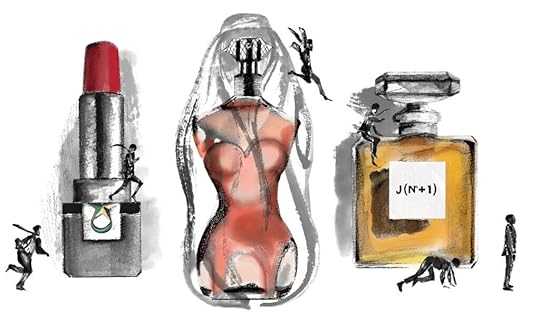
Illustration by Matthew Fox (@matteo_zorro).
New Recruits
The vast office in which the group of Black men find themselves is open-plan. No walls interrupt the space separating them from the glass cage emblazoned with the three letters—CEO—that mark the territory of the alpha male. A huge picture window generously affords a view over the rooftops of Paris. Forms are handed out, left, right, and center. Here, they are recruiting: recruiting security guards. Project-75 has just been granted several major security contracts for a variety of commercial properties in the Paris area. They have an urgent need for massive manpower. Word spread quickly through the African “community”: Congolese, Ivorian, Malians, Guineans, Beninese, Senegalese.
Everyone takes out the various papers required for the interview: the identity card, the traditional résumé, and the CQP, a kind of official permit to work in security. Here, it is portentously dubbed a diploma. Then there is the cover letter: “To Whom it May Concern,” “part of a dynamic team,” “a profession with excellent career prospects,” “in keeping with my skills and training,” “please be assured,” et cetera. In a place like this, the medieval circumlocutions and ass-kissing phrases of motivational letters become risible. After all, everyone in the room has a powerful motivation, though what it is may be very different depending upon which side of the glass one finds oneself on. For the alpha male in his glass cage, it is maximum turnover. Hiring as many people as possible is part of the means. For the Black procession outside, it is an escape from unemployment or a zero-hour contract by any means necessary. Security guard is one of those means. The training is absolutely minimal, employers are all too willing to overlook immigration status, the morphological profile is supposedly appropriate: Black men are heavyset, Black men are tall, Black men are strong, Black men are deferential, Black men are scary. It is impossible not to think of this jumble of noble-savage clichés that is atavistically lurking in the mind of every white man responsible for recruitment, and in the mind of every Black man who has come to use these clichés to his advantage. But that is not at issue this morning. No one cares. And, besides, there are Black men on the recruiting team. Everyone fills out his form with a modicum of diligence. Last name, first name, sex, date and place of birth, marital status, Social Security number: this will be the most demanding intellectual challenge of the morning. Even so, a few of the men glance at their neighbors’ forms. Someone coming out of a long period of unemployment lacks self-assurance.
After signing and initialing a few white pages blackened with esoteric phrases, every member of the group is given a bag containing a pair of black trousers, a black jacket, a black tie, a shirt that may be white or black, and a monthly work roster indicating the times and places of shifts. Those who already have experience in the profession know what lies in store in the coming days: spending all day standing in a shop, until the end of the month comes and they are paid. Paid to stand—and it is not as easy as it might seem. In order to survive in this job, to avoid lapsing into cozy idleness or, on the other hand, fatuous zeal and bitter aggression, requires either knowing how to empty your mind of every thought higher than instinct and spinal reflex or cultivating a very engrossing inner life. The incorrigible-cretin option is also highly prized. Each to his own method. Each to his own goals. Every man who comes into these offices unemployed leaves a security guard.
Vocabulary
In the Ivorian community in France, the security guard is such a ubiquitous profession that it has spawned a terminology, one inflected with the colorful expressions of Nouchi, the popular slang of Abidjan.
Standing-Heavy: designates all professions that require the employee to remain standing in order to earn a pittance.
Zagoli: specifically refers to the security guard. Zagoli Golié was a famous goalkeeper with Les Éléphants, the national team of Côte d’Ivoire. Being a security guard is like being a goalie: you stand there watching everyone else play and, once in a while, you dive to catch the ball.
MIB
At the branch of Sephora on the Champs-Élysées, the security guard wears a black jacket, black trousers, black shirt, black tie. He works his shift with four other Men in Black and a supervisor who sits behind a bank of monitors surveying footage from the forty cameras bristling around the boutique. He has a walkie-talkie connected to a transparent earpiece. A swanky guard for a swanky avenue.
“Sephoraaa” or “Sephoooora”
This Sephora is one of the largest in the world. As people step inside, or sometimes simply as they’re walking past, they often shriek as though they’ve just spotted an old friend they are about to run to and embrace: “Sephoraaa!” (version française); “Oh my God! Sephoooora!” (English version).
The Prairie
The Sephora store is long and narrow, and the black-and-white-striped pillars are reminiscent of a basketball umpire. To the right, color-coded orange: Men’s Fragrances. To the left, color-coded pink: Women’s Fragrances. To the rear, color-coded green: Face and Body Care. This zone is nicknamed the Prairie, as much for its color as for the luxury Swiss skincare brand La Prairie, which sells the most expensive item in the store: a “caviar cream” that costs nine hundred euros for a hundred milliliters.
Sense(s)
In the perfume aisles, soft lighting is deployed to heighten the sense of smell. In the makeup aisles, harsh lighting is deployed to heighten the sense of vision. Everywhere, Muzak is deployed to heighten the sense of deafness.
The Shoe Carrier
A young Japanese man enters with a Prada bag slung over his shoulder and, in one hand, dangling from a carabiner, a plastic gadget on which hangs a pair of visibly worn sneakers: this is a Zpurs shoe carrier. The man is currently wearing a pair of blue sandals, and the security guard imagines him performing a quick-change when it starts to rain, shrieking “Banzai!” When we do not understand the Other, we invent it, usually with racist clichés.
J( n+1 )
The MIBs at Sephora communicate with one other via earpieces, tracking suspects or supposed shoplifters according to their morphotype using codes that conform to a numerical sequence with the formula J(n+1), in which n is an integer.
J3: Arab.
J4: Negroid.
J5: Caucasian.
J6: Asian.
The security guard does not dare ask what call signs should be used for persons of mixed race. J4/5 mixed Black and Caucasian? J3/6 Arabo-Asian? J6/4 Black Asian… Given its high rate of interracial marriages, the security guard cannot help but think that in Brazil, his counterparts must have a much more complex formula.
The Emir’s Wife
Cloaked, from head to toe, in a black veil, her every step reveals a glimpse of a patent leather stiletto and an ankle encircled by the cuff of a pair of jeans that, one imagines, tightly hugs the rest of the leg. She is accompanied by a servant, an aide, and a bodyguard. They are easily recognizable. The servant, a young Filipina woman with a particularly pimply face, is carrying bags from every luxury emporium from the Place Vendôme to the Champs-Élysées. The aide, a rather effeminate Arab man, has the Woman in Black’s handbag tucked under his arm and holds her credit card conspicuously, between his index and middle fingers. The bodyguard is the man carrying three umbrellas who trails meekly after them.
Americanophiles
An Arab couple. The husband wears a T-shirt printed with a map of the New York subway. The wife, in full veil, is wearing a grey boubou with sleeves stitched from fabric printed like a ten-dollar bill. Clearly visible on her left elbow is the motto of the United States of America: in God we trust.
Relegation
The clothing-store axiom “A customer without a bag is a customer who will not shoplift” does not hold true at Sephora. This, ipso facto, relegates the axiom to the status of a mere theorem. At Sephora, underpants, bras, pockets, scarves, baseball caps, gloves, baby buggies—in fact, anything that can be worn on the human body or used to transport small human bodies—are susceptible to being used as a cache or as a means of concealing an item that has not made the requisite stop at the cash register.
MIB and WIB
At Sephora, the Men in Black are the security guards; the WIBs, the Women in Black, are those who wear the niqāb.
Confusion
From time to time a WIB wearing the fullest veil slips a lipstick or an eyebrow pencil beneath her niqāb. The security guard is convinced he has caught a shoplifter red-handed, until he notices that, in her other hand, the WIB is holding a small mirror that also disappears beneath the veil.
The Hijab and the Hoodie
No one is allowed to enter Sephora wearing a hoodie with the hood up. But it is perfectly not forbidden to wear the hijab, or even a niqāb. What approach should the security guard take if he should see a young woman coming in wearing a hoodie over her burqa?
Floko
A white woman comes into the store carrying a bag on which is printed a large red colonial fez.
In French colonial Africa, the gardes-de-cercle were brutish, moronic Africans who were cruel and zealous in carrying out the orders of their white masters. In Bambara, the word floko means a little bag. The foreskin, which looks like a little bag at the end of the penis, is also called a floko. Metonymically, the word is used to refer to those who are uncircumcised. In countries where circumcision is often a rite of passage, an initiation into adulthood and personal and collective responsibility, being called uncircumcised is particularly insulting. Loathed by the people for their brutality, the gardes-de-cercle were nicknamed floko guards. Each wore a red fez.
For Whom the Metal Detector Tolls
The walk-through metal detector tolls when anyone enters or leaves with an item that has not been demagnetized. It signals only hypothetical guilt and, in 90 percent of cases, the item has been duly paid for. But it is striking to note that almost everyone heeds the command of the security gate. Hardly anyone is insubordinate. However, reactions differ according to culture or nationality:
The Frenchman looks around, as though someone else were responsible for this noise and he is merely looking for the culprit—in the spirit of collaboration.The Japanese customer stops dead and waits for the security guard to approach.The Chinese shopper does not, or pretends she does not, hear, and continues on her way as nonchalantly as possible.The French citizen of Arabic or African ancestry accuses the device of conspiracy or racial profiling.The African jabs a finger at his chest as though seeking confirmation.The American rushes over to the security guard with a broad smile and all bags open for inspection.The German takes a step back in order to check that the system is functioning correctly.The Gulf Arab adopts a lofty, supercilious expression, and slowly stops.The Brazilian puts his hands in the air.Once, a man actually fainted. He was unable to confirm his nationality.
Dior J’adore
This perfume exerts a powerful magnetic attraction on Arabic, Chinese, and Eastern European women. The boutique runs an informal daily sweepstakes for the buyers of Dior J’adore. Yesterday, the grand prize went to the United Arab Emirates, to a woman who had €1,399.76 worth of Dior J’adore in a shopping basket that came to a total of €3,456.85.
Fast ATM
Seven seconds, including the time needed to enter the pin: this is how long it takes the HSBC ATM on the Champs-Élysées to spit out twenty euros. It takes forty-three seconds for the Crédit Lyonnais on the rue Louis-Bonnet in Belleville to perform the same task. On the Champs-Élysées, money is quickly dispensed, and just as quickly expended. In poor neighborhoods, even cash machines are reluctant to hand over cash.
Break
In the lingo of security guards, “to take a break” means to stand in for a colleague at another shop while he takes a break. In this way not only does he do a favor for his colleague, he notches up another hour’s overtime. This is also a way of discovering other shops.
Break at La Défense
At the Sephora outlet in La Défense, the head of security is an Ivorian of a certain age who goes by the nickname Éric-Coco. He is completely possessed by the spirit of Chanel.
“While I’m in the back, you keep an eye on the Chanel, especially the six-point-eight-ounce No. 5s.”
“What?”
“People tend to steal the large No. 5. Oh, and the three-point-four-ounce Allure. I need you to stop them.”
“Okay, but what exactly are we talking about?”
“We’re talking about Chanel, for god’s sake! Chanel No. 5 and Allure de Chanel. Perfume. Premium perfume. Why do you think you’re here?”
Break in Levallois-Perret
In this Paris suburb with bourgeois delusions, the Sephora outlet is in the paved, pedestrianized town center, next to all the other brands that exude fake luxury and fake sophistication. The boutique is not very big, and all the departments are within eyeshot of the security guard, who does not even need to turn his head. Inside, the atmosphere is muted; staff and customers whisper, perhaps to avoid disturbing the sacred perfumes, perhaps to avoid altering their chemical composition with raised voices. In an outlet of this kind, shoplifting is rare.
Break in Vincennes
The shop in Vincennes stands right outside the castle. Back in the days when it was inhabited by a Louis the Umpteenth, body care and bathing were vanishingly rare.
Police Presence
The avenue des Champs-Élysées is teeming with plainclothes police officers. They always wear jackets, regardless of the season, and white earbuds, plugged into iPhones on which they livestream the mug shots of France’s most wanted. They are easily identifiable at five hundred paces but believe they are utterly invisible. As we say back in Assinie: “Everyone can see a swimmer’s back, except the swimmer.”
Revolutionaries
So pleased were young Tunisians by the Jasmine Revolution they had launched in their own country and by the overthrow of the dictator Ben Ali that battalions of them took the Mediterranean by storm and found themselves in France. With little education and a limited grasp of the language of Jamel Debbouze, left to their own devices, they spend their days in Paris much as they did in the ghettos of Sousse or Tunis: between idleness and petty theft. For them, the height of elegance and fashion is to dress like the young people from the French banlieues. But they have neither the swagger nor the lingo and, as a result, are easily recognizable.
Security guards have dubbed them the revolutionaries.
“Heads up, three revolutionaries prowling around the Good Dye Young stand!”
“Revolutionary uprising in Bath and Body.”
“Man the barricades, the revolutionary in the red baseball cap has a Sauvage body spray in his underpants.”
A “revolutionary” has been seen in the act of shoplifting. Until he leaves the shop, he cannot be searched or considered a thief. But if he jettisons the fragrances whose packages he exenterated, he must pay for them. There follows a surreal low-speed chase in which security guard and shoplifter calmly wander around the shop side by side. After almost half an hour of this preposterous game, the revolutionary cracks and loudly and intelligibly demands his own arrest. Down his trousers, two bottles shaped like clenched fists: Diesel, Only the Brave.
Auction
All of the sales assistants at Sephora are awarded performance-related bonuses from the products they represent. All of them have developed techniques for luring customers in and persuading them to buy one perfume rather than another. Most simply spray the passing customer with perfume or hand out presoaked scent strips while babbling a few words.
But one of the male sales assistants has become famous for his technique, which involves interspersing his praise for the perfume with carefully disguised slogans from the 1968 student protests. A week ago, he was proclaiming the glories of Bleu de Chanel:
Beneath the paving stones, the beach…
Bleu de Chanel.
A fragrance that is beguiling, bewitching, bewildering.
Allow yourself to be beguiled by the sensual notes of musk, bewitched by bright notes of bergamot.
A breath of amber wreathed in a cloak of castoreum.
Beneath the paving stones, the beach…
Next week, he will be working the Givenchy concession. His spiel will begin, “Be realistic, demand the impossible…”
Esprit de Corps
Still standing: the trait of the security guard.
Esprit de Corpse
Still standing: the fate of the security guard.
Thief
The floppy chestnut fringe, the flawless side parting, the perfectly ironed blue-gray shirt, the immaculate black trousers that fall over neatly polished shoes—all these make him look like a British prime minister in mufti. Yet there is something incongruous in this portrait of the ideal brother-in-law. It is unusual to have a backpack and a shoulder bag when dressed as though you are about to give a PowerPoint presentation to an urban-planning consultancy. His nonchalant air as he stands next to the Dior concession is a little “hammy.” A filmmaker’s term. This man is “iffy.” A security guard’s term. But no one has seen him do anything suspicious. Confirmation comes over the headset: “J5 in a tie at the Dior concession—nothing to report.” The Dior concession is the first the customer encounters when he enters the store, or the last as he leaves it. Will the man venture farther into the store or leave straightaway? With his sidelong looks and his squinting, it is the security guard who now looks “shifty.” A thief’s term. The man does not move. He enters into a conversation with one of the salesgirls. The security guard cannot hear a word of what is being said. The salesgirl smiles. Apparently, the man is pleasant company.
On this early summer evening, the store is thronged with customers, making it impossible to focus on one man. A large group enters. Their accents are Slavic. Poles? Russians? Czechs? Their shoes are covered with a fine but visible layer of white dust. They have clearly been to the Louvre and amassed this layer of dust walking through the Tuileries Gardens. It is the most direct route from the Louvre to the Champs-Élysées, and most tourists stroll all the way to the Arc de Triomphe. The branch of McDonald’s next to Sephora is where they stop off after this marathon. The staff at Mickey D’s call them the palefoots.
A palefoot woman approaches the security guard. She is accompanied by a sullen child clutching a balloon shaped like a smiling Mickey Mouse on the end of a plastic stick. She wants to know where to find the Métro. The security guard points. The gaping maw of George V Métro station is fifty yards up the street. Glancing over the woman’s shoulder, the security guard sees the man with the floppy fringe. He is creeping out of the store, hugging the far wall. Their eyes meet. In both of their minds, a penny drops. The man is quick off the starting blocks, sprinting down the avenue. The security guard is slower to react. The long hours spent standing have left his joints stiff. Whoever the thief is, he now has a ten-yard head start. He glances over his shoulder and sees that the security guard is running after him. There are no shouts, no screams.
The Champs-Élysées is crowded. The thief zigs, the security guard zags. At the thirty-meter mark, the security guard’s biomechanics grind into gear. Glancing over his shoulder again, the thief notices. In a feat of remarkable dexterity, he manages to disentangle the bag slung over his shoulder without breaking his stride, and tosses it behind him. Jettisoned ballast, a votive offering, or both. But the security guard keeps going. He had anticipated this maneuver; he hurdles the bag before it even hits the polished granite slabs of the pavement. The thief continues to zig, the security guard to zag, faster and faster. The thief’s necktie flutters behind him, hovering parallel to the ground in the headwind. The security guard’s tie does likewise. A few more meters and the thief will be within his grasp. Suddenly, the traffic light ahead turns red, and, familiar with the highway code, he stops. But this is merely a coincidence. In the mind of the security guard, another red light flashes. What is he thinking running after this man? What if he’s armed and dangerous? What great moral imperative is satisfied by pursuing a perfume thief? This is probably how you contract floko guard syndrome. The colonial guard with his white truncheon, his inane grin, and his fez… red. Red means stop. The thief vanishes into the crowd. The security guard retraces his steps. In the jettisoned shoulder bag, he finds three bottles of perfume: Elixir Pour Homme by Azzaro, Diesel’s Fuel for Life, Allure by Dior.
Translated from the French by Frank Wynne.
GauZ’ is the pen-name of Armand Patrick Gbaka-Brédé, born in Ivory Coast in 1971. His first novel, Debout-Payé, was awarded the Prix des libraires Gibert Joseph and chosen as best debut novel of the year by the magazine Lire. Debout-Payé, translated as Standing Heavy, will be published by MacLehose Press in May 2022. GauZ’s most recent novel, Camarade Papa, won the 2019 Prix Éthiophile.
Frank Wynne is an Irish literary translator. He has translated numerous French and Hispanic authors including Michel Houellebecq, Javier Cercas, and Virginie Despentes. His translations have been awarded the IMPAC Dublin Literary Award and the Independent Foreign Fiction Prize, and he has twice been awarded both the Scott Moncrieff Prize and the Premio Valle Inclán. He has edited two major anthologies, Found in Translation: 100 0f the Finest Short Stories Ever Translated (2018) and QUEER: LGBT Writing from Ancient Times to Yesterday (2021).
February 11, 2022
The Review’s Review: Mathematics of Brutality
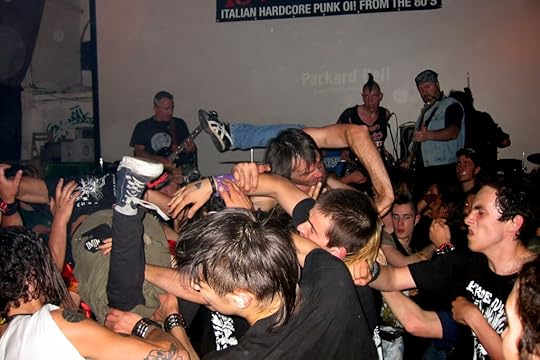
Image courtesy of Wikimedia Commons.
“A revolution is not a dinner party, or writing an essay, or painting a picture, or doing embroidery,” goes Mao’s famous dictum. “A revolution is an insurrection, an act of violence in which one class overthrows another.” The aftereffects of this kind of violence on a nation’s citizens is the subject of the South African writer C. A. Davids’s new novel How to Be a Revolutionary, out from Verso this month. In chapters that crisscross between present-day Shanghai, apartheid-era Cape Town, Beijing during the suppression of the Tiananmen Square protests, and a series of McCarthy-era letters from Langston Hughes to a South African friend, Davids follows the friendship of Beth, a South African diplomat, and Zhao, a Chinese writer, as they come to terms with the moments of betrayal, naivete, and political cowardice in both of their pasts.
But history, like revolutions, is complicated, and Davids is sensitive in her portrayal of the impossible choices that ordinary people face during moments of acute political crisis. “Do not forget,” writes Zhao in a manuscript that will appear on Beth’s doorstep early in the book, “that there exists a mathematics of brutality where the amount of blood spilled is inversely proportional to emotional resonance, so that after the first viewing of an act of inhumanity one begins to grow numb somewhere inside one’s head and heart.” Writing isn’t a revolution—but it is a way of recording one’s humanity. —Rhian Sasseen
I Never Promised You a Rose Garden, the debut graphic work from Mannie Murphy, plays on the myth of Portland as a liberal haven, a city of roses sequestered from the far-right enclaves that pockmark the rest of the state. It begins as a rumination on River Phoenix, and the artsy punk Portland crowd that took him in, and mushrooms into an account of white nationalism in the Pacific Northwest. The book hinges on the hate crime that alit Portland in 1988, the murder of Mulugeta Seraw, a college student who had moved to the city from Ethiopia to study business. It traces the connections between Phoenix, Keanu Reeves, Gus Van Sant (who made Phoenix his pet), the punk club owner Mr. X, and the killer, Kenneth “Ken Death” Mieske, another of Van Sant’s teenage muses and a member of the neo-Nazi gang Eastside White Pride. I Never Promised You a Rose Garden paints a portrait of a fraternity for the vulnerable, the volatile, and the bigoted. Murphy demonstrates that the history of Oregon itself is bathed in white supremacy, its founding tied to the aspiration for a white ethnostate. Murphy recounts Ken Death’s murder trial and its resonance outside the courtroom, and also acts as amateur investigator, tracking down incriminating details in old footage, and as a memoirist: Murphy grew up in Portland, attended the same K-12 school as Phoenix, and crushed on him as a fan. Murphy’s handwritten cursive script, which accompanies the illustrations on lined newsprint, oozes the naivete and intimacy of a diary entry or elementary school composition book—a fitting choice for a book that is both confession and corrective history lesson. Their illustrations, drawn with a paintbrush, are in the gray and indigo palette of that drippy city. Each one dimples in the places where pools of water-soluble ink have bled through and dried. It’s rare to find a graphic artist whose captions and drawings are balanced in their storytelling power, but Murphy is one.
Like Murphy, the photographer and textile artist Lisa Anne Auerbach is ambivalent about the legacy of punk. At seventeen, she’d go to all-ages shows in Chicago, pull out her camera in the middle of the mosh pit, and shoot the sweat-streaked faces streaming past her, the teenagers in their homemade band tees, the boots in the air, and the skinheads swinging by with their bare torsos and shining scalps. She developed the Tri-X film in her high school darkroom and hung on to the negatives for over three decades. A selection of these photos, taken in the spring of 1985 at the clubs Cubby Bear and Cabaret Metro, were recently assembled into the gorgeous photobook PIT. Published by the Glasgow-based workers co-op Good Press in 2021, the book is slim and potent. It includes a great introduction by LAA, full-page black-and-white photos printed on rich card stock and paired as diptychs, and an interview with the artist conducted by Ethan Swan, a writer of DIY communities and music subcultures. “I wanted to document the choreography and ecstasy of the pit, the half naked bodies, the camaraderie and ritual and aggression,” LAA writes. She also discusses the mechanics of nostalgia and the ethics of reproducing images like these, in which you can glimpse, knocking against and mixed into the mash of bodies, the hardcore racist with his uniform of leather, pins, and Aryan skin burning under the camera flash. You can’t look at the pit without also seeing a space where full-on and “fashion” skinheads alike might be purging some of their antagonism. PIT speaks to the countless things the pit came to be for those who eyed it from a distance, haunted its fringes, and tossed around in it: “The audience moved like a wave, a mass, a school of fish, a pile of garbage. We responded to music, to movement, to one another. The pit was codified and random, organic and tempestuous.” —Jay Graham
February 10, 2022
Narcotics
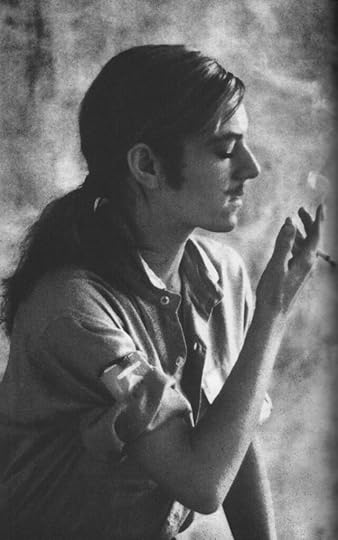
Gary Indiana, Cookie as my ex-boyfriend, New York, 1980.
I was at a sedate little cocktail party in SoHo, one of those uneventful parties I wound up at once a week. It was a typical SoHo art shindig: there was a full bar, sliced raw veggies and clam dip, bread sticks, mini-wieners and pea-size meatballs floating around in red sauce in a hot stainless-steel pan. The usual bunch of scrubbed, aspiring, New York art climbers were there mingling and tittering and chit-chatting discreetly, the women in sensible low heels and expensive stockings with no runs, and the men in silk ties, designer sports jackets, and clean jeans.
A few of the men with goofy-looking bloodshot eyes were passing around marijuana; the ladies were giggling and tossing their sleek pageboy hairdos around, acting like they’d never seen marijuana before. These women were young, fresh out of college, but they were always trying to make themselves look old for some reason. I never understood that. They wore gray baggy dresses and a few pieces of tiny, tasteful, conservative jewelry.
There was a man standing near me at the butlered bar, flirting with one of those bland-looking, corn-fed debs in gray. They were smoking a joint. The girl—this perky, peppy, preppie—started to cough, and he laughed and attempted to cuddle her for her cuteness. He turned to me only long enough to hand me the joint.
“Here,” he said, “you look like the type that could handle this.”
“No thanks,” I said, “I don’t use drugs … only narcotics.”
That was the truth. I’d stopped using marijuana. It made me paranoid.
The person I’d come with, Alvain Arles, the art critic and historian, came over to me.
“This is a real bore. A snore fest. Let’s get out of here,” he said. Alvain was many things, but never boring. He had a hard time tolerating people who were. I hurled back my martini and we slipped out the door.
“You think UFO or SHELL SHOCK will be out yet over on Fourth Street?” he asked.
“I don’t think so. But ROADRUNNER or SEVEN UP or NAUSEA ought to be out on Seventh Street,” I said, as we tried to hail a cab.
“How about T.N.T. or DOLT BOLT?” he said in the cab, counting his money, “they’re a little stronger.”
“Let’s just head straight for 10th Street for POISON or BLACK DEATH,” I said, “they’re always open. They have TOXIC and RADIOACTIVE there too.”
“So where’ll it be?” the cab driver asked.
“Just head for the east side,” Alvain said. “How about IMPALE or PEG-LEG? VIRGIN DEVIL, X- RATED? Or PARALYZE or WALLOP or LOT O’ROT?”
“Never had any of those except WALLOP. I don’t even know if WALLOP still exists. You have to go for the newest stuff … after a week or two the quality always plummets. How about SWEET SIXTEEN or TRUE BLUE? Wait, wait! Why not TOILET?”
“Hey!! Okay!! Yeah!! TOILET’s out now, so’s TORTURE!” He got excited. “Driver, take us to East Third Street and Avenue B,” he said, and settled back, happy. “TOILET and TORTURE. Either one is great.”
We were talking about heroin. These were the names rubber-stamped on the little glassine packages of ten-dollar amounts sold on the Lower East Side streets. Junkies, weekend users, and other heroin aficionados memorized all the names by heart; they knew where to get each one and exactly what time the “store” opened.
I wondered what this cab driver thought. Maybe he thought we were going over the names of our favorite exploitation films or dirty books, or discussing S&M bars.
We got to the corner of Third and B, and Alvain hopped out. “You hold the cab,” he said. “It’ll take one second.”
The cab driver waited for four seconds and then he turned to me, “Hey, I don’t wanna sit here. I’m losing fares,” he said.
“Don’t worry. We’ll make it worth your while,” I said.
“No. Pay up, I gotta go.”
I gave him the money and got out. That was a drag. Ordinarily, it was no calamity being without a cab, but I was looking a little too spiffy in my cocktail regalia for that neighborhood at that hour in that time of the decade. I was also holding the rest of Alvain’s money, and junkies can smell money, especially if they’re thieves or dope sick. I looked around for Alvain and saw him down the block talking to a Puerto Rican guy in red-and-white running clothes, probably flirting, because the guy was cute and he was Alvain’s type. I walked up to them and heard the Puerto Rican say, “Yeah, TORTURE’s smokin’ righ’ now. I seen ’em carron out somebody who jes O.D.ed on it. You give me ya money an’ I’ll git it fa ya.”
“And that’d be the last I’d see of you,” Alvain laughed. “No, I know where to go.”
The guy kept trying to think of some way to get some money from us, and he walked beside us talking nonstop. I could tell that Alvain was falling in love.
“Okay, I’m gonna give ya one of my bags,” Alvain said, and gently tweaked the Puerto Rican’s beardless chin.
We walked over to the burned-out building where people were lining up in the dark hallway, clutching their money, waiting to buy. Everyone was very quiet. The first guy in line put three ten-dollar bills through a slot in a door in the back of the hall and out of the slot came three glassine bags of TORTURE.
A big black guy standing at the hall entrance was keeping everything moving. He worked there. “Hurry up, move along, have your money ready, step up,” he was saying.
A punk rocker in front of me was talking to a skinny Italian American guy, “Yeah, somebody jes O.D.ed on this shit minutes ago. Must be the best shit on the street right now.”
“Told ya,” the Puerto Rican reminded us.
“Great!” another person in line said, “I’m lucky I came out now.”
“Yeah, my ol man was sa high on TORTURE yestada, he was throwin’ up all ova da place,” said a skinny birdy girl in a blue leather jacket. “Was goooood sheeet, man!”
“Shhh!” said the big guy at the entrance.
Mixed in with the losers and hardcore users were a few prosperous types waiting in line: a Wall Street man, a blonde-haired model I’d seen in last month’s Vogue, a famous post-minimalist sculptor, a famous filmmaker, and a guy I’d seen once on some daytime soap opera, Another World, or The Edge of Day, or City Hospital. I can never remember the names of those shows.
When Alvain and I got to the dope door, Alvain slipped his money through the slot and out came six little white rectangular packages, taped with clear tape and stamped with the word TORTURE. With the goods, we bustled out the building and walked fast off the block. Alvain gave one to the Puerto Rican, and the Puerto Rican disappeared. Alvain was temporarily heartbroken.
He got over it immediately when we saw a cop car cruising down the avenue. Instant paranoia. If they decided to stop us, we would go directly to jail for the night, even if we’d had just one measly bag between us.
I heard the lookouts, young kids who worked for the dope houses from the rooftops, start yelling, “Bajando! Bajando!” That was the Spanish alert. It meant the cops were coming. We saw people walking very fast out of the building we’d just come from. Another watcher from the corner yelled, “Don’t run! Calm down! Don’t run!” People on the street who were heading toward the building just turned in their tracks and walked fast the other way. In less than two minutes the street was empty. The whole thing was really organized. By the time the cop car appeared around the corner and cruised slowly in front of the building, everything was peaceful.
I’d seen a funny scene one day at a dope spot on Rivington Street. People were lined up against a waist-high wall, waiting to score. Suddenly the alert went out, a cop car was coming, so the seller and all the people in line dropped on all fours and were hidden by the wall. After the car went by, it was business as usual, everybody just stood up.
The sellers were always trying to be one step ahead of the cops. A few dope houses were doing the routine where the sellers would lower a basket from the window on a rope, the customer would put in his money, and the basket would be raised. Down would come the packages of dope. When the cops came, the basket would be raised quickly and the crowd would disperse. The dope scene had no room for sloppy salesmanship. There were many workers.
Before the cop car got to us, we found a cab right on the next block. That was luck. We drove past Ninth and B and there was a guy with a knife standing over a person who’d been in line at the building we’d just come from. The guy on the ground wasn’t hurt, he was reaching into his pants pockets, pulling out his heroin, and handing it over. As we whizzed past I heard him cursing, “Shit. Dammit, now I’m gonna be sick. Common, man, leave me jes one bag. Fuck!”
“Poor kid.” Alvain looked back at the scene.
“He ain’t gonna hurt ’im,” the cab driver said. “He’ll pralee leave him one bag too.” Anyone on the streets there at that hour knew what was happening.
“Good thing we found you when we did,” Alvain told the cabbie.
“Yeah. I saw you two in line,” he laughed. “Where to?”
Friends of mine who went to buy dope in that neighborhood would sometimes have their watches, earrings, rings, and all their drugs and money taken. An artist friend had gone there right from an opening and he’d been all dressed up in his leather jacket, his cowboy boots, his best wool tweed pants. The person who ripped him off at knife-point wasn’t satisfied with just the dope and his money. The thief also took the jacket, boots, sweater, tweed pants, and even my friend’s boxer shorts. Stark naked, he started running home, freezing. On his way he searched the garbage cans for something to wear and finally found a dirty pink sweater, so he put his legs in the sleeves and ran, hoping he didn’t see anyone he knew. At least his wang was covered.
I laughed uproariously when he told me this story. In retrospect he too admitted it was very funny, but at the time he’d been mortified.
Things like this were always happening there. Friends would occasionally get arrested and wind up in jail for the night, or they’d lose their rent money. I’d never known anyone to get stabbed, but I’d never known anyone stupid enough to refuse to give up their stuff to a thief with a knife. Some people, new to street copping, would give their money to guys they thought were dope-house runners. Of course these “runners” wouldn’t ever return. If you happened to find a real runner, he would come back with the dope, but he’d take one or two bags for the run. So it was expensive and sometimes dangerous over there. For that reason, a couple of friends started selling heroin from their homes.
Barbara did. She’d written a mammoth novel that weighed something like ten pounds. She lived with her paramour, Jane, who was a rock and roll musician. They were good friends of mine before they started selling dope, and while they were selling it I saw them every day. Way more pleasant than the street, there was always a fire burning in the fireplace, lots of books on the shelves and flowers in vases. The cats were curled up on the chairs, there was the smell of fresh coffee. It was a home.
A few close friends would visit Barbara and buy some heroin. She made some money, everyone was happy. A habit takes months, sometimes years of dabbling with the stuff before it creeps up on you. I think a lot of these people were shocked to find themselves dependent on heroin even though they weren’t shooting it but snorting. Some people are dumb enough to believe you can’t get a habit if you aren’t using a syringe. At a certain point, a lot of the people I knew were using heroin, and some of them had habits, but no one took it too seriously. Everyone would always joke about it and everything was playful … but … being dope sick wasn’t pleasant, or fun, or romantic. Baudelaire, Poe, Coleridge, and all those writers who flirted with opiates didn’t write much about the sick part.
A heroin habit isn’t a problem for the user until there’s no money. I remember one New Year’s Eve party, held at this chic French restaurant, where all the guests were high on heroin. Everyone’s pupils were pinpoints; everyone was in a vegetable state, and acting cool like cucumbers. All eyes were dry at the stroke of midnight, and there wasn’t a whole lot of laughter; there wasn’t much outward display of emotion, like there was at drinkers’ parties, but in their black little junky hearts everyone was feeling warm and loving, they just couldn’t show it.
Everyone was standing up and mingling and talking; if they’d sat down they probably would have nodded out. They were all really good friends, people who’d gotten to know each other from the Mudd Club days before, and it was great to see everybody, even through the dopey haze of dope. These heroin users, like drinkers everywhere, had used the New Year’s Eve excuse to get higher for this night, and everyone was as stoned as they could be. At one point, after midnight, I turned to a filmmaker friend of mine.
“Look around,” I said, “Do you realize that every single person here is high on heroin? It looks like a Zombie Jamboree.”
He scanned the group, “You’re right,” he said, and laughed. I told everyone, and everyone laughed about it. We all had a good time that night, even though a lot of people were dozing off on their feet, buoyed up by the crush of friends around them. Yeah, everyone had fun, even the people who missed most of it because they were in the bathroom throwing up, or snorting more heroin.
It wasn’t like those typical SoHo art parties, like the one where they had passed marijuana around, where the guests had never known scary 4 A.M. walks in the heroin neighborhood, where none of them ever was dope sick, or ever ran home wearing a dirty sweater on their butt, or ever went without food for three days because there wasn’t enough money for food and dope too. Those people, the dope innocent, who never found themselves suddenly in a lowdown compromising situation of need, seemed like adolescents to a junky. The non-users were a whole different set of people. They might have been smarter for never getting involved in dope, but it’s a fact that when junkies become ex-junkies, they’re somewhat the wiser, having seen hell.
Cookie Mueller, née Dorothy Karen Mueller, played leading roles in John Waters’s Pink Flamingos, Female Trouble, Desperate Living, and Multiple Maniacs. She wrote for the East Village Eye and Details Magazine, performed in a series of plays by Gary Indiana, and wrote numerous stories that would only be published posthumously. She died in New York City of AIDS-related complications at age forty.
A version of this previously unpublished piece will appear in Walking Through Clear Water in a Pool Painted Black, New Edition: Collected Stories , which will be published in April by Semiotext(e).
February 9, 2022
A Dew-Lined Web: On Sula
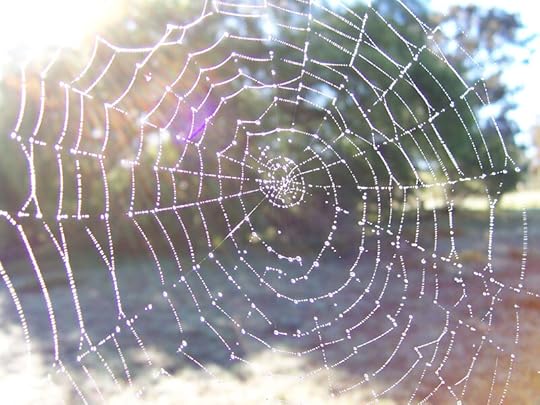
Image courtesy of Wikimedia Commons.
It’s the name. Sula. That’s what always strikes a space between my breasts whenever I think of Toni Morrison’s second novel, published in 1973, and my favorite of her oeuvre. There are other proper names in Morrison’s titles—Solomon, Tar Baby, Beloved—but they do not wear their allegory so lightly. Sula always seems to me to name a person, not an idea. She is, of course, a type, but she is the type of person who exceeds typology. She’s the kind of woman about whom you start to say “she’s the kind of woman…” even though you know any words that follow will twist like winter leaves before they hit the air, will fall to the ground, dry and dead wrong.
Sula is a real character, as we say. Sula is incomparable, matchless, singular. There is nobody like Sula. And yet. I’ve seen Sula in my days, in my sisters, my aunts, my friends, a stranger crossing the road. Morrison saw Sula in someone, too, before she wrote her:
I began to write my second book, which was called Sula, because of my preoccupation with a picture of a woman and the way in which I heard her name pronounced. Her name was Hannah, and I think she was a friend of my mother’s. I don’t remember seeing her very much, but what I do remember is the color around her—a kind of violet, a suffusion of something violet—and her eyes, which appeared to be half closed. But what I remember most is how the women said her name: how they said “Hannah Peace” and smiled to themselves, and there was some secret about her that they knew, which they didn’t talk about, at least not in my hearing, but it seemed loaded in the way in which they said her name. And I suspected that she was a little bit of an outlaw but that they approved in some way. (The Source of Self-Regard, 241)
In the novel, this remembered Hannah is Sula’s mother, Hannah Peace, but she is also Sula.
The paradox of Sula is that she’s quintessentially herself—nobody is like her—but she’s also everybody we know who is like that. This paradox takes shape in different ways in Sula, in the novel’s preoccupations with ironic oppositions, with how the individual self-relates to the collective, with the dynamic relation between order and disorder. As is Morrison’s tendency, all aspects of the novel—I am drawn in this writing to its names—flow through these interlocking thematic valves, coordinating like an intricate machine or body.
***
The novel is named for a character whom we don’t really meet for thirty-odd pages. Sula begins instead with a fictional place—Medallion, Ohio—and specifically with “that part of town where the Negroes lived, the part they called the Bottom in spite of the fact that it was up in the hills.” This paradoxical name comes from “a nigger joke,” the kind told by both white folks and colored folks “when they’re looking for a little comfort.” Morrison here sets up the first of many dizzying spins between high places and low, from treetops to holes, from hilltops to mud, from the aeronautical skies to tunnels and trenches. This species of irony—“it was lovely up in the Bottom”—is technically called antiphrasis, but it just means calling something by its opposite, how we sometimes call a hefty man “Slim” or a tall one “Tiny.”
Antiphrasis is at work in the names of several characters in Sula. We meet a grown man named BoyBoy. We meet a pale man named Tar Baby. We meet a woman everybody calls Teapot’s Mamma “because being his mamma was precisely her major failure.” Late in the novel, we learn that the people of the Bottom have a general “disregard for name changes by marriage” and mark four gravestones with the surname Peace. “Together they read like a chant,” Morrison writes, a chant as eerie as it is holy, given that none of the dead comes to their end in peace or rests in peace after.
And then, of course, there are the deweys:
Eva snatched the caps off their heads and ignored their names. She looked at the first child closely, his wrists, the shape of his head and the temperament that showed in his eyes and said, “Well. Look at Dewey. My my mymymy.” When later that same year she sent for a child who kept falling down off the porch across the street, she said the same thing. Somebody said, “But Miss Eva, you calls the other one Dewey.”
“So? This here’s another one.”
Eva bestows the name Dewey upon three boys—whose skin is respectively “deeply black,” “light-skinned,” and “chocolate”—for a quality she sees in each, as if matching some inner thing to the outer label. But each dewey becomes “in fact as well as in name a dewey—joining with the other two to become a trinity with a plural name … inseparable, loving nothing and no one but themselves.” The chain gang game they play enacts their concatenation: “With the shoelaces of each of them tied to the laces of the others, they stumbled and tumbled out of Eva’s room.” The boys stop growing, so they do not become different from each other over time; eventually, not even their mammas can tell the deweys apart.
Each of these reversals of nominal expectation is but a slight topsy-turvy amid the mellifluous waves of Morrison’s prose. Yet this tic of antiphrasis casts all names into doubt. Names are meant to pinpoint a person, fix them as a discrete entity, not entangle them or flip them around. But, as Morrison says of the real-life Hannah Peace, even the way a name is spoken can change it indelibly, like the cover of a song. Sula plays with and overturns the usual logic of marking an individual’s uniqueness with a name, the same logic that we see both in Sula’s belief that her best friend, Nel, “was the first person who had been real to her, whose name she knew,” and in Sula’s horror upon learning that the man she has always known as Ajax is actually Albert Jacks (A. Jacks): “when for the first time in her life she had lain in bed with a man and said his name involuntarily or said it truly meaning him, the name she was screaming and saying was not his at all.”
If you can be named for something you’re not, for somebody other than yourself, are you real, are you truly yourself? If your name can dissolve and recombine into another name, who are you anyway?
***
This mystery of the self, of our shared but unbreachable condition of singularity, twinkles like a string of lights through the novel. The first time young Nel leaves Medallion and meets her grandmother Rochelle—“this tiny woman with the softness and glare of a canary”—she returns with an epiphany:
“I’m me,” she whispered. “Me.” Nel didn’t know quite what she meant, but on the other hand she knew exactly what she meant. “I’m me. I’m not their daughter. I’m not Nel. I’m me. Me.” Each time she said the word me there was a gathering in her like power, like joy, like fear.
Me is a name that only you have and that everybody else does, too; this is the uncanny magic of pronouns.
Nel is herself but late in the novel, she tries to distinguish herself from Sula, only to be reminded: “You. Sula. What’s the difference?” Because despite their individuality, the two girls are as deeply connected as the deweys and in a manner just as fantastical. Sula and Nel first meet one another in their dreams, each sensing that “watching the dream along with her, were some smiling sympathetic eyes.” Like Nel’s epiphany of self-regard, this “intense … sudden” friendship with Sula is both consummately specific and hauntingly familiar.
When I think of Sula and feel that thrum at my breastbone, I’m thinking of the tart green sap of girlhood (“Hey, girl,” they say, “girl, girl, girlgirlgirl”). I’m remembering the “adventuresomeness” of young girl friendship, the “mean determination to explore everything” together, truly everything, and the perfection of this sentence: “And they had no priorities.” I’m conjuring the teetering into fleshly doings that happens at a certain age when, suddenly, like a flock of birds erupting into flight, all of the boys are beautiful: “It was in that summer, the summer of their twelfth year, the summer of the beautiful black boys, that they became skittish, frightened and bold.”
I’m feeling this trembling time, its desire and ache, “their small breasts just now beginning to create some pleasant discomfort,” this girlish queerness—neither straight nor lesbian exactly, but feverish with slant possibility—this dewy conspiracy of selves:
Together they worked until the two holes were one and the same. When the depression was the size of a small dishpan, Nel’s twig broke. With a gesture of disgust she threw the pieces into the hole they had made. Sula threw hers in too. Nel saw a bottle cap and tossed it in as well. Each then looked around for more debris to throw into the hole: paper, bits of glass, butts of cigarettes, until all of the small defiling things they could find were collected there. Carefully they replaced the soil and covered the entire grave with uprooted grass.
Neither one had spoken a word.
Again, what strikes me is the scene’s combination of strangeness and familiarity: the weird games children play when they are outside and have no toys; the sense that as a young girl, I, too, played this way with, became one with, other young girls (whose names I know: Hilda, Chanda, Nyaka). Even the smallest details of the scene—the literal bits and pieces Sula and Nel throw in their merged hole—shudder between the random and the archetypal.
***
This suits the novel’s interest in waste: every other page refers to shit, piss, butts, asses, stool, outhouses, restrooms, bladders, or constipation. (The Bottom is a triple pun at least). The girls’ burial of “small defiling things” comes after two other episodes of oblique abjection, one familial, one erotic. In the first, Sula overhears her mother speaking dismissively about her and feels radically severed from home, cast out like slops. In the second, Sula and Nel run a gauntlet of male gazes (“pig meat,” Ajax calls after them), secretly thrilled by what lies curled behind the seams of the men’s trousers. The hole-digging scene in turn foreshadows later sexual entanglements and gruesome deaths, some requiring a closed casket.
The scene itself climaxes in a beautiful and horrifying death—horrifying because it is beautiful—that both binds the two girls together and, when she tries to ensure that he has not witnessed it, binds young Sula to Shadrack for life. In this novel, the abject—filth and mess, all that is beyond the bounds, the realm of the “jettisoned … where meaning collapses”—is, oddly enough, a binding agent (Julia Kristeva, Powers of Horror, 2). This symbiosis of order and disorder appears throughout Sula—Nel lives in “the high silence of her mother’s incredibly orderly house, feeling the neatness pointing at her back,” while Sula is “wedged into a household of throbbing disorder constantly awry”—but especially in Shadrack’s story, which itself sits on the outer edges of the novel.
Shadrack’s name points us to the Book of Daniel, where King Nebuchadnezzar II throws three men, one named Shadrach, into a furnace for refusing to bow to the king’s image. This biblical tale echoes the immolation of Sula’s uncle and mother in the novel, as well as the hellhole Shadrack finds himself in during World War I: “he turned his head a little to the right and saw the face of a soldier near him fly off.” Shadrack’s trauma as a veteran makes him unravel. His fingers seem “to grow in higgledy-piggledy fashion like Jack’s beanstalk” and to join up with his shoelaces: “The four fingers of each hand fused into the fabric, knotted themselves and zigzagged in and out of the tiny eyeholes.”
But he’s soothed by the “neat balance” of a food tray separating rice, tomatoes, and meat: “All their repugnance was contained.” And so, when he returns to Medallion, he invents National Suicide Day “to order and focus experience,” to make “a place for fear as a way of controlling it”; “if one day a year were devoted to it, everybody could get it out of the way and the rest of the year would be safe and free.” His shack on a riverbank on the outskirts of town is a spatial version of National Suicide Day, a place of containment beside a muddy slurry.
When young Sula walks into his home that fateful day to see about a death, she’s struck by how clean and neat it is, despite housing such a chaotic mind. The relationship between girl and man is thin and taut, brief yet consequential. Their conversation revolves around one word—“Always”—that holds radically different meanings for each. This eventful, contingent day brings Shadrack a shred of humanness to hold onto; the child’s belt that Sula drops becomes “the one piece of evidence that he once had a visitor.” And this day also serves as the crucible that forges that unaccountable being: Sula, the woman.
***
Who—or what—does Sula become? Sula the woman is beautiful and loose; she works little and discards people; she sleeps around with the men in town and catches feelings for one. On one hand, Sula is completely understandable, the natural outgrowth of her mother and grandmother, who are cruel to women but adore men. On the other hand, Sula is utterly alien. When she’s caught with another woman’s husband, they’re on their hands and knees licking each other’s lips like dogs, neither of them notably aroused. When Sula does fall in love, she imagines her paramour’s body in this unsettling way: “Skin black. Very black. So black that only a steady careful rubbing with steel wool would remove it, and as it was removed there was the glint of gold leaf and under the gold leaf the cold alabaster and deep, deep down under the cold alabaster more black only this time the black of warm loam.”
Sula is “like any artist with no art form … dangerous.” Her material is life—“hers was an experimental life”—and she creates two major works of art, the Bottom and her own self: “I don’t want to make somebody else. I want to make myself.” In each case, she creates via negation, by rubbing herself off, carving herself out: “She had no center, no speck around which to grow … She was completely free of ambition, with no affection for money, property or things, no greed, no desire to command attention or compliments—no ego.” This emptiness is crucial to her art but it is also threatening. It makes Sula extra in every sense: too much, a “wayward stranger,” a “pariah.”
Yet Sula is necessary, essential to the black people of Medallion. This is because they have a precise understanding of evil, one that is akin to Shadrack making a place for fear rather than trying to dispel it:
Their conviction of Sula’s evil changed them in accountable yet mysterious ways. Once the source of their personal misfortune was identified, they had leave to protect and love one another. They began to cherish their husbands and wives, protect their children, repair their homes and in general band together against the devil in their midst. In their world, aberrations were as much a part of nature as grace. It was not for them to expel or annihilate it. They would no more run Sula out of town than they would kill the robins that brought her back…
Sula’s evil makes the good rise in others; her bad brings out their best; her wrongs make them right.
While some critics interpret the birthmark over Sula’s eye as the biblical mark of Cain, the divergent and quotidian readings of the birthmark in the novel itself (other characters see it as a rose, a snake, ashes, a tadpole) suggest not just spiritual symbolism, but also worldly, deeply human ambiguity. Each person sees the particular evil in her that they need to. The community doesn’t cast Sula out or set out to sacrifice her; everybody knows deep down that her magnificent, maleficent presence is what unites them. Sula isn’t in fact a scapegoat but a supplement, the allegedly “unnatural” extraneous piece that turns out to be missing from the center. (Jacques Derrida writes in Speech and Phenomena: “We can speak … of a primordial ‘supplement’: their addition comes to make up for a deficiency, it comes to compensate for a primordial nonself-presence.”)
When Sula’s gone, everybody misses her; they miss hating her and measuring themselves against her. When Sula’s gone, everything collapses.
Who, and what, she is therefore isn’t merely a question of personality. It’s a question of philosophy: “That’s how philosophy started … One of the first questions one could pose … is the question of the difference between the who and the what … Do I love someone for the absolute singularity of who they are? I love you because you are you. Or do I love your qualities? … The history of love, the heart of love, is divided between the who and what.” (Derrida, in Derrida, by Kirby Dick and Amy Ziering Kofman).
If what Sula is to us is an emblem, a mirror, a type, a supplement of the community—and she is all of these things—we must always remember that who Sula is belongs, in the end, to her friend. “We was girls together,” Nel cries and it strikes me in my chest like the point of a pin hitting a gong.
***
Sula is Nel. Sula is Rochelle, Nel’s grandmother, who also wears yellow and brings birds. Sula is her mother, Hannah, who also fucks all the men in the Bottom. Sula is her grandmother, Eva, who also kills a boy. Sula is Shadrack, another outcast whose hellfire teems at the edges of the community, sealing it whole. And Sula is herself, Sula Mae Peace, as well as every possible unraveling of that triple rippling name, which only on this latest rereading did I think to look into.
As with many of Morrison’s names, Sula Mae is biblical. Sula Mae is Shulamit or Shulamite, the name of Solomon’s beloved in the Song of Songs, the woman whose “lips drop sweetness as the honeycomb.” Sula Mae could also be Salome—either the temptress who danced for King Herod and demanded the head of John the Baptist at the behest of her fiery mother, or a female disciple who witnessed Christ’s crucifixion. Both the names Shulamit and Salome come from the root word shalom, or peace. So, Sula Mae Peace is Peace Peace, a doubling that seems to jar her loose from herself, and makes us wonder whether she is one of the peaces in that graveyard, or all of them. And Sula spelled backward—is it “all us” or “alas” or “a lass” or “a loss?”
Sula is all of these possibilities, every line of light on a dew-lined web. But no matter how many times I reread Sula, analyze her names, untangle her threads, the light of her slips through my fingers. Some small thing that lives in my chest and has a bell for a tongue knows the truth of the matter: Sula is Sula.
From Namwali Serpell’s introduction to the new reissue of Sula, published by Vintage Classics.
Namwali Serpell is a professor of English at Harvard University and the author of Seven Modes of Uncertainty (2014), The Old Drift (2019), Stranger Faces (2020), and The Furrows (September 2022).
February 8, 2022
Structure Is a Design in Light: The Notebooks of Louis I. Kahn
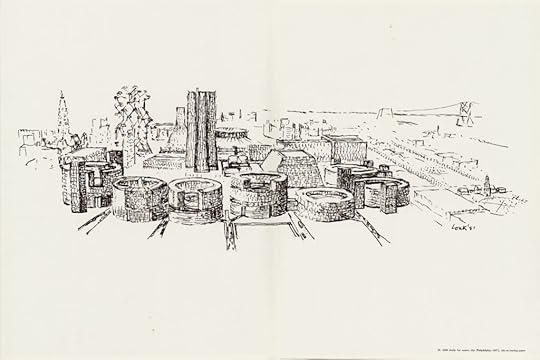
Louis I. Khan, 1956 study for center city Philadelphia, ink on tracing paper.
A selection from the architect’s notebooks and drawings, including sketches from his European travels as well as early drafts and finished renderings of his buildings.
One day, as a small boy, I was copying the portrait of Napoleon. His left eye was giving me trouble. Already I had erased the drawing of it several times. My father leaned over and lovingly corrected my work. I threw the paper and pencil across the room, saying “now it is your drawing, not mine.” Two cannot make a single drawing. I am sure the most skillful imitation can be detected by the originator. The sheer delight in the act of drawing has its way in the drawing and that also is a quality that the imitator can’t imitate. The personal abstraction, the rapport between subject and the thought also are unimitatable.
In the presence of Albi [Cathedral], I felt the belief in the choice of its architectural elements, and what exhilaration and patience were combined to begin it and work toward its completion. I drew Albi from the bottom up as though I were building it. I felt the exhilaration. The patience it took to build, one didn’t need, for I drew it without bothering about corrections or correct proportions. I wanted only to capture the excitement in the mind of the architect.
As notations in music reveal structure and composition for hearing, the plan is the score that reveals the structure and the composition of spaces in natural light.
The plan expresses the limits of Form. Form, then, as a harmony of systems, is the generator of the chosen design. The plan is the revelation of the Form. To an architect the whole world exists in his realm of architecture … when he passes a tree he does not see it as a botanist but relates it to his realm. He would draw this tree as he imagined it grew because he thinks of constructing. All the activities of man are in his realm, relating themselves to his own activity.
A few years ago I visited Carcassonne. From the moment I entered the gates, I began to write with drawing, the images that I learned about now presenting themselves to me like realized dreams. I began studiously to memorize in line the proportions and the living details of these great buildings. I spent the whole day in the courts, on the ramparts, and in the towers, diminishing my care about the proper proportions and exact details. At the close of the day I was inventing shapes and placing buildings in different relationships than they were.
The editors chose several sketches of mood and development of a few projects rather than isolated drawings of a greater number of projects. Such a decision appeals to the architect who starts, like the writer and the painter, with a blank piece of paper upon which he imprints the gradual steps in the development of something he wants to make exist. The sketchbooks of painter, sculptor, and architect should differ. The painter sketches to paint, the sculptor draws to carve, and the architect draws to build.
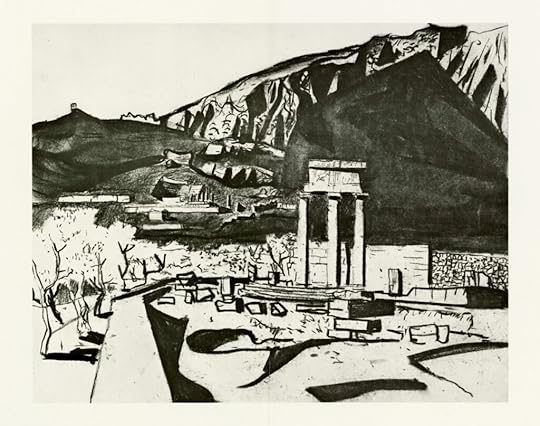
1951 Delphi from Marmaria, Greece, crayon in notebook.
Reflect on the Pantheon, which is recognized as one of the greatest of buildings. Its greatness has many facets. It is the realization of a conviction that a building could be dedicated to all religions and that this ritual free space can be given expression. It presents a belief of a great man, which led to its design as a nondirectional domed space. If architecture may be expressed as a world within a world, then this building expresses it well, even refining it, by placing the oculus, the only window, in the center of the dome. This building had no precedents; its motivation was clear and full of belief. The force of its “wanting to be” inspired a design equal to its desires in form.
Today, building needs an atmosphere of belief for the architect to work in. Belief can come from recognizing that new institutions want to emerge and be given expression in space. New beliefs come with new institutions that need to be expressed as new spaces and new relationships. The architectural realizations sensitive to the institutions’ particular form would set a new precedent, a new beginning. I do not believe that beauty can be deliberately created. Beauty evolves out of a will to be that may have its first expression in the archaic. Compare Paestum with the Parthenon. Archaic Paestum is the beginning. It is the time when the walls parted and the columns became and when music entered architecture. Paestum inspired the Parthenon. The Parthenon is considered more beautiful, but Paestum is still more beautiful to me. It presents a beginning within which is contained all the wonder that may follow in its wake. The column as a rhythm of enclosure and opening and the feeling of entering through them to the spaces they envelop is an architectural spirit, a religion that still prevails in our architecture today.
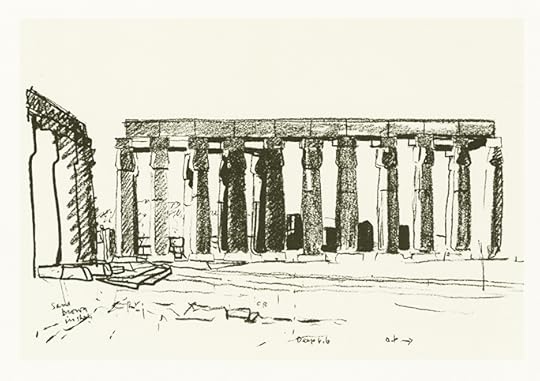
1951 Luxor, Egypt, crayon in notebook.
A space can never reach its place in architecture without natural light. Artificial light is the light of night expressed in positioned chandeliers not to be compared with the unpredictable play of natural light. The places of entrance, the galleries that radiate from them, the intimate entrances to the spaces of the institution form an independent architecture of connection. This architecture is of equal importance to the major spaces though these spaces are designed only for movement and must therefore be designed to be bathed in natural light. This Architecture of Connection cannot appear in the program of areas—it is what the architect offers the client in his search for architectural balance and direction.
The client asks for areas, the architect must give him spaces; the client has in mind corridors, the architect finds reason for galleries; the client gives the architect a budget, the architect must think in terms of economy; the client speaks of a lobby, the architect brings it to the dignity of a place of entrance.
Architecture deals with spaces, the thoughtful and meaningful making of spaces. The architectural space is one where the structure is apparent in the space itself. A long span is a great effort that should not be dissipated by division within it. The art of architecture has wonderful examples of spaces within spaces, but without deception. A wall dividing a domed space would negate the entire spirit of the dome.
The structure is a design in light. The vault, the dome, the arch, the column are structures related to the character of light. Natural light gives mood to space by the nuances of light in the time of the day and the seasons of the year as it enters and modifies the space.
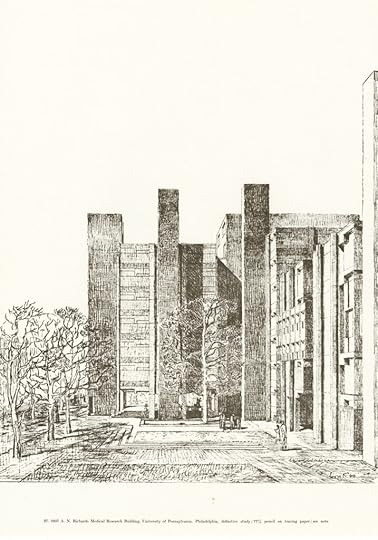
1957 A.N. Richards Medical Research Building, University of Pennsylvania, Philadelphia, definitive study, pencil on tracing paper.
In Gothic times, architects built in solid stones. Now we can build with hollow stones. The spaces defined by the members of a structure are as important as the members. These spaces range in scale from the voids of an insulation panel, voids for air, lighting and heat to circulate, to spaces big enough to walk through or live in. The desire to express voids positively in the design of structure is evidenced by the growing interest and work in the development of space frames. The forms being experimented with come from a closer knowledge of nature and the outgrowth of the constant search for order. Design habits leading to the concealment of structure have no place in this implied order. Such habits retard the development of an art. I believe that in architecture, as in all art, the artist instinctively keeps the marks that reveal how a thing was done. The feeling that our present day architecture needs embellishment stems in part from our tendency to fair joints out of sight, to conceal how parts are put together. Structures should be devised that can harbor the mechanical needs of rooms and spaces. Ceilings with structure furred in tend to erase scale. If we were to train ourselves to draw as we build, from the bottom up, when we do, stopping our pencil to make a mark at the joints of pouring or erecting, ornament would grow out of our love for the expression of method. It follows that it would become intolerable to hide the source of lighting and unwanted ducts, conduits and pipe lines by pasting acoustical material over structure. The sense of structure of the building and how the spaces are served would be lost. The desire to express how it is done would filter through the entire society of building, to architect, engineer, builder, and craftsman.
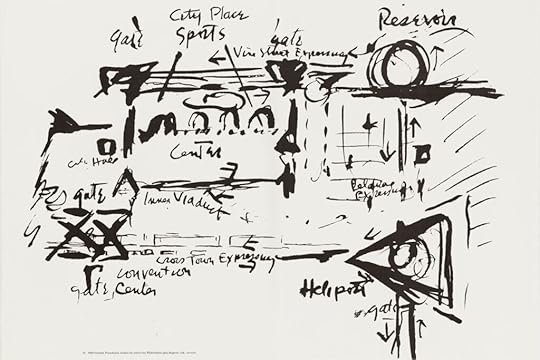
1962 Graham Foundation studies for center city Philadelphia, plan diagram, ink.
Excerpt from The Notebooks and Drawings of Louis I. Kahn. The book was originally published in 1962, and will be reissued along with a new Readers Guide by Yale University Press this April.
Redux: An Ordinary Word
Every week, the editors of The Paris Review lift the paywall on a selection of interviews, stories, poems, and more from the magazine’s archive. You can have these unlocked pieces delivered straight to your inbox every Sunday by signing up for the Redux newsletter.
The writer and translator Claudia Durastanti was born in the U.S. to Italian parents, both deaf, who never taught her to sign. She spent much of her young life shuttling between Brooklyn and Basilicata, and between the two countries’ native tongues. “When I write in English,” she told the Daily last week, “I’m making the reverse journey from the one I’m used to—English to Italian—so I’m obsessed with correctness. But then I don’t think it’s good writing. Usually, when you allow yourself impurities, the writing is actually stronger.” Read on for more from contributors to our archives who have journeyed between languages and nations: Dany Laferrière—the first Haitian and the first Quebecois to join the Académie française—on the nuances of the French dictionary; Beth Nguyen on her fractured relationship with her mother, who was left behind when the rest of the family immigrated to the U.S.; a wry poem by the hard-of-hearing, multilingual poet Ilya Kaminsky; and the Iranian-born Swiss photographer Shirana Shahbazi’s portraits of goftare nik (good words).
If you enjoy these free interviews, stories, poems, and portfolios, why not subscribe to The Paris Review? You’ll get four new issues of the quarterly delivered straight to your door.
Interview
Dany Laferrière, The Art of Fiction No. 237
Issue no. 222 (Fall 2017)
If a word that was used by Flaubert or Césaire falls into desuetude, if it becomes passé, we still keep it in the dictionary because it was used by an important writer. The dictionary strives to recognize the creative usage of writers. Our commission not long ago tackled the word sexe. So we looked at how writers use a word like sexe—all the different notions, phrases, and implications that have come up over the years. The Marquis de Sade doesn’t have the same thoughts on the matter as, say, the Marquise de Sévigné. An ordinary word can take up half a page in the dictionary. A word like sexe can run to six or seven pages.
Nonfiction
Apparent
By Beth Nguyen
Issue no. 232 (Spring 2020)
Over the course of my American life I have spent less than twenty-four hours with my mother. We have never spent more than an hour or two together at a time. If I see her it’s only because I’m in Boston for some other reason and I’ll call my father so he can call her to arrange a visit. I need his easy Vietnamese to figure things out, to decide the time when I must show up at her apartment. And then she and I just sit there, maybe drink some tea, maybe talk about her pet cockatiels. I ask her questions she won’t really answer.
Poetry
From “Last Will and Testament”
By Ilya Kaminsky
Issue no. 227 (Winter 2018)
Be careless, life!
Wrap me in newspaper on a park bench
so some enterprising schoolchild
can filch from my eyes
two dimes
and replace them with two U.S. postage stamps.
Art
Goftare Nik (Good Words)
By Shirana Shahbazi
Issue no. 172 (Winter 2004)
If you liked what you read here, don’t forget to subscribe! In addition to four print issues per year, you’ll also receive complete digital access to our sixty-eight years’ worth of archives.
The Paris Review's Blog
- The Paris Review's profile
- 305 followers











